#me when i actually recognise the motifs and themes moment
Text
so, anyone who knows me from previous blogs knows i’m an absolute music nerd who’s worked on both film score and musical theatre book before (and is still working in that vein, though i’m combining it with script writing these days)
and, god, i would be doing such an injustice to whoever is writing the soundtrack for the sandman if i didn’t talk about it at least once, because it’s one of the best tv scores i’ve ever heard, i wanna teach this as an example of how to do it right
i’ll be here for days if i try to cram all of it into one post, so i’m gonna focus on episode six, the sound of her wings, because that’s the one that really gripped me
(under the cut though to save dashboards bc this is still me and it will still get long)
so, to break this down, there’s a lot of different ways to add musical motifs (leitmotifs) into tv, but sandman is a show that does it (mostly) by character. in this episode we see a lot of dream’s motif, death’s motif, desire’s motif, and a slight appearance of johanna’s when the earlier constantine shows up (hob doesn’t have one, but i’m betting that’s deliberate). which makes sense for such a character driven show, especially in a story that’s got many anthology aspects - not much stays the same in this show but the characters, they are the through-line, and even the changing characters from episode to episode help give each episode its own musical feel
(people have said that sandman would work better with weekly episodes than binging, and this is part of why - they're very self contained, each episode a new vibe, and whether you notice it or not the soundtrack is contributing to that)
back to our episode 6 breakdown - so this is death’s motif, in its simplest form. and (barring a little of dream's when he's explaining why he's upset) this motif is the only motif we hear in the entire first half of the episode

the reason i’d wanna teach this is mostly that it’s not easy, developing a motif without making it stagnant. it’s actually the first thing we ever covered when i studied music composition, because they really wanted to get it into our heads - anyone can make up a melody, but our brains notice patterns. and the really effective patterns consist of, at most, four notes. in a sense, the notation i’ve added above is actually the motif four times, just phrased as a question, a pause, a question, and an answer. and developing a motif into a score means changing it enough to give it direction, but keeping it similar enough that it’s recognisable. and that’s a hard thing to do! but we spend a full 20 minutes with just this motif, and it not only never gets boring, it’s developed into such a beautiful moving score, going from this very simple theme that just exists in the background to a huge emotional orchestral piece
and in terms of what it's actually doing character wise, i wanna focus on those gaps in the original. bc those are some long pauses between each three note repetition. and i think that is a good representation of death, and her patience, this theme isn't trying to rush you into anything, it's just sitting there reliably for when its time comes.
but as we go through that development, those pauses start being filled. it's still just as much about death as ever, but we understand it more. and the development starts to take on a more hopeful character the more of these snapshots of people's lives that we see. and the music is telling us how dream is feeling, as he goes from not understanding death, to learning a lot more about her, to being overwhelmed by how easy it is to care about these random people in the last moments of their lives, and how death isn't a bad thing
it simplifies back down, near the end of their walk, because she's still the same person she was at the start of the episode, it's dream that's changed, but it doesn’t go entirely back to the motif we heard at the start. those gaps are now filled by gentle woodwinds, the understanding remains. and as soon as we say goodbye to death (specifically “i thank you, my sister”), we switch immediately to dream's motif
(technically, dream has two, but i associate one more with dream and one more with the dreaming, so i'm talking about the former)
now, we’ve heard this one a lot already, it's the title music for the show, here it is for the sheet music fans (you may notice it’s asymmetrical, the contrary bastard)


and we’re about to hear it even more - it's playing constantly from that goodbye right up until the start of the flashback (in more medieval sounding instrumentation than usual, alluding to the fact that hob is at the forefront of his mind), and we’ll hear the same thing coming back out of the flashback, too
now, within each flashback scene, there largely aren’t repeating motifs. and i mentioned this was probably deliberate - the music we hear in the background of each scene is fitting to the time period, and i think that in a way is hob’s musical identity. the thesis statement of sandman as a story is that you have to keep changing to keep living, and you have to keep living to keep changing, it’s why hob’s never ending immortality isn’t angsty like so many other immortals - he’s going to keep changing and keep living and it’s always going to be worth it. so his musical identity changes too, relative to wherever and whenever he happens to be living.
but then we get the moments where dream’s motif overtakes that -
1389, we actually get death’s first, when we first hear hob talking about how death is stupid and he’s not going to die, and it switches to dream’s with “why would any sensible creature crave an eternity of this?” (and back to death’s with “very well, little brother”, all three play off each other for the rest of that scene)
1489 is very much hob’s scene, there’s elements of dream’s motif in the arpeggios that pick up after “it’s fucking brilliant”, because now he’s caught dream’s interest, but it’s still largely the 15th century music, we only hear dream’s motif properly once he gets up to leave, and hob has to shout after him “you never told me who you are!”
in 1589, it starts to creep into the music (though still in hob’s native instruments), when shakespeare says “to give men dreams that would live on long after i’m dead”, and it overtakes it fully when dream leaves the table
the only moment in the flashback sequence which doesn’t have era appropriate music, is 1689, when hob is telling the story of how miserable the last 80 years have been. the music matches his mood, but it’s using modern digital instruments - this isn’t hob, not really. and while there’s no element of dream’s motif in this scene that i can spot, when we get “death is a mug’s game”, that’s when we switch back to the 17th century instruments, because this is the hob we know, the one who is always willing to live, no matter what
1789, dream’s motif when dream says “you need not have come to my defense”, through to the rest of that scene, this one stands out as a moment where he's not grabbing power, but sharing it
1889, when else - it comes in with “then i shall take my leave of you and prove you wrong”
1989, it’s so faint. it took me a minute to actually confirm that was dream’s motif - it doesn’t show up at all in the main scene, but when we switch to the view of dream in the cage, we hear a very hidden version of it, changed to the point of being almost unrecognisable
and then 2022. and we hear it in full again, but not just it in full. it gets an orchestral, uplifting development, both in tribute to the fact that this scene is very hopeful and heartwarming, but also explicitly mimicking the development death’s motif had when dream was watching her work, realising how much he cared about these random people, realising how much he therefore cared about people he’d known for much longer. her influence and her lesson is extremely present here, as she was the one who pushed him into returning
and as that scene ends, the music overlays with Desire by Bob Moses and Zhu, which is the cleverest part of the whole episode
because yes, the song is named desire, and has the word desire in its lyrics, telling you who this is, and yes, in an episode that has so far been full of medieval or orchestral music, the EDM is a sharp vibe twist, which fits with both desire’s character and the fact that their gallery in the show is styled to be very modern art/avant garde compared to dream's more renaissance style
but that’s not all it’s doing
because here’s the thing about desire. they absolutely have a motif in this show, that plays in the background every time they are on screen or talked about. but it’s not a melodic motif.
desire’s motif is the sound of a heartbeat
(often with accompanying ambient synths, but no melody)
and you don’t notice it when you’re just watching for the story, but every time you see desire on this show, there is a heartbeat playing in the background. and if you listen to this particular song, the dance beat is also mimicking a heartbeat, allowing it to blend in perfectly with desire’s existing motif, which is also playing in the background here
it’s just. brilliant
#like this was the most surface level analysis i could do! this is a rabbit hole that just keeps going i could be here for WEEKS#it's so wonderful#maybe i just gotta start doing a series of music breakdowns#next week: the corinthian and how he gets existing songs rather than his own score/motif#to represent the fact that he's constantly trying to mimic humanity but isn't#the sandman#1x06#dream of the endless#death of the endless#hob gadling#desire of the endless#mine#sandman score analysis#music
79 notes
·
View notes
Text

[copied over from my cr blog, also this is gonna get long, i’d apologise but im not sorry]
okay, so
this is a rant probably about 7 years in the making, bc when i first watched lok i had not done any music study, i had not done any composing of my own, my knowledge of music theory was at a primary school level and i still thought tv soundtracks were just made by one person composing a whole cache of music and then the audio editors pick and choose what track to place where
(spoiler alert that’s not how film and tv scoring works, i have now done a music composition course where we had to score a short film, among other things, and i have so much more respect for tv composers jesus christ)
but this one stuck out to me even way back then, bc me barely knowing what a leitmotif was was like “hey this one little refrain keeps popping up whenever bolin does lavabending, and i like it, i’m gonna see if it’s on the soundtrack”
it was not, and that’s sort of where i left it back in 2014, but i actually did a rewatch of lok pretty recently out of nostalgia, and then noticed it even more
and to explain why (and this is also a little bit why five’s stuck out to me in tua, i’ll get to that in another ask), let’s cover, leitmotifs, and tv scoring in general
so a leitmotif is basically just a short musical idea that represents something in a piece of music. when i studied motivic development we were encouraged to make that motif four notes or less, and then develop it into something longer (aka a theme), because if you can constantly come back to a really short idea while keeping the piece moving, that’s what makes a piece of music memorable
(you can ignore those rules on purpose but that’s a different essay)
so the most common way that a leitmotif shows up in soundtracks is to represent a character or a location - you play the motif when that character shows up or when you’re in that location and boom, the audience associates that motif with that person place or thing, and you can then use this to tell the audience things without actually telling them. for example, star wars playing the imperial march whenever someone does something darth vader related - darth vader isn’t on screen, but you can feel his presence, because his music is playing
and if we were a film score, where we have two hours to show one particular character’s development, great! we give them a simple motif, and then as they grow as a person we change their motif to reflect what is happening to them, until we end up with something that communicates on a subconscious level how much they’ve grown. we toss in as much symbolism as we can, and we have a really great soundtrack that’s instantly memorable
tv scoring, is harder. partially because of time constraints (have you ever composed half an hour of original music a week, and had to make sure it fits perfectly with every beat of what’s happening on screen? these guys have), partially because there’s a much larger focus on ensemble casts
so what atla and lok do, for the most part, is not score individual character motifs for everyone. this is fairly common in tv soundtracks, instead we score ideas, concepts, and feelings - these’ll come up a lot more and give you more information than just “oh hey this character’s on screen”
the avatar state, for example, has the strongest and most recognisable theme across both shows. i’m linking an atla track in here because it has the best example but you’ll know this shows up with korra too - and with particularly important moments for wan, for kyoshi, etc. they also appear in the opening of both shows, four strong notes that start and end on the same note (in the case of what i’m linking, it’s an F#)
youtube
the first part of this track is the more uncertain, pensive theme that comes up when both avatars are feeling doubt/worry/sadness, but then it transitions into the more recognisable four. worth noting though, those are both basically the same motif. if i write them out back to back, you’ll notice they both have four notes and start and end on F#. if i had to guess, four notes four elements, and it comes back to the start because the avatar is a cycle.

korra has a theme for when she’s fighting, but not an individual character theme. the airbenders as a concept have a theme, republic city has thematic instruments, as do some big name characters, like iroh and his tsungi horn (this is also a cross-series thing, he’s always playing it in atla, it shows up when zuko has to make big moral decisions, and when we first meet iroh in the spirit world in lok, it shows up there too, to let the audience know who this is before we properly see him)
so, if korra doesn’t get a single theme and instead has several for different aspects of her life, and mako and asami follow along with the mood of the story like all the other characters, the fact that bolin has a personal leitmotif at all, let alone a solid, developing one, is pretty remarkable!
now, granted, it mostly starts with book 3, before then he was like every other character, but it has clear symbolism through those last two books! and, initially i thought it was related only to his lavabending, since that’s most of when it shows up, but since my rewatch, i’ve started calling it his hero theme
see, when people wanna criticise mako and bolin, usually the comments they get are that bolin’s too immature and mako’s too serious/uptight. but like, that’s how they work, you can’t analyse either of them without the context of the other. since they were little kids on the streets, bolin chases his heart and mako makes sure they don’t die from it, that is their entire childhood. and neither would have got here on their own because mako wouldn’t take the necessary risks and bolin wouldn’t take the necessary precautions. (like. remove either one from the equation and they’d still be working for the triple threats bc s1 and their flashback miniseries make pretty clear that bolin got them out and mako kept them out)
and then book 2 proves it! because it splits team avatar up, and what happens? bolin is totally taken advantage of by varrick and used as a pawn in his evil plan and mako ends up in jail
so what’s book 3, to them? it’s, being able to find themselves without having that codependency. mako no longer has someone to protect, which is what he’s based his whole life around so far - bolin’s doing fine and he’s no longer dating either korra or asami. and bolin’s trying his hand at some of that responsibility (look at how he immediately adopts kai who is explicitly them but younger because he wants to be the older brother for once). most importantly, they find the rest of their family, and stop being defined by being orphans. they don’t have to be that singular piece of a puzzle, they can just be themselves. and that’s where bolin’s character really starts to shine, because that’s when they bring in the bending plot, and bending, perhaps more than any other character, really gets to the heart of who bolin is
if you want more of my thoughts on that i have an essay here, but tl;dr: bolin’s an extremely powerful earthbender, but he’s not a metalbender because metalbending requires you to double down on the earth characteristics and think like an earthbender, and bolin doesn’t, he’s too fluid for that, which is one of his major strengths, so of course he can lavabend
and finally - to his motif itself! (as a note, i’ve put all of these in the same key to show where it repeats, but there’s a variety of keys used in the show)
as far as i can find, it first shows up in s3e8, when bolin stuns p’li with this well placed shot
[Edit: it first showed up in the s2 finale, but again in a simplified version and again with him doing something heroic with earthbending, so we can still start the analysis here]
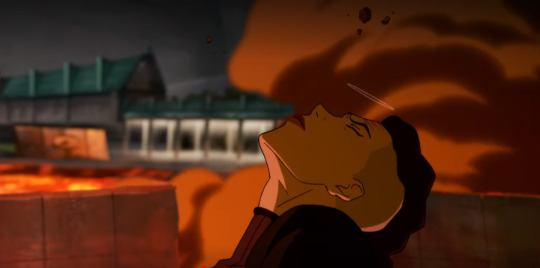
mako volunteers bolin for that job, because he knew bolin was capable of it. why? because bolin landed an identical shot earlier in the episode, after trying to metalbend, getting frustrated he can’t, and cheating with some extremely well aimed earthbending. it’s just a short refrain and you barely notice it, but it’s the first connection of this motif with the theme of bolin’s bending
it looks like this, and it’s always played on a trumpet, which is part of why i call it the hero theme, because, if you’re looking at music from a western perspective, trumpets were used to herald kings, and then used to represent military glory, and then when superhero themes started happening, they used trumpets too - it’s basically western music shorthand for hero these days
(it’s also symmetrical so that helps with the good vibes)

and he’s saving everyone here, so it’s linked to his bending, but it’s also linked to his heroism
it ties the two together, and they are tied together.
when’s the next time it shows up? episode 10, when the brothers are in prison in ba sing se, and bolin tries to metalbend them out. again, he’s doing this to save people, and this motif gets a few notes added on to the end in a raising pattern - they’re inspiring, but they don’t go anywhere. which is exactly what happens in the scene, because he’s trying to go about this in the wrong way. mako believes in him, but it won’t (and doesn’t) work

it appears in episode 12 when bolin saves everyone from ghazan destroying the temple, in a more fancy orchestral remake of the first version - it’s impressive, but it hasn’t actually developed yet, it’s just his discovery of it
the book 3 finale already has its own fucking amazing soundtrack, i love that entire episode’s score, but it gets its own moment there too, and the first real development!
because what we hear is not what we’ve heard before. we know it’s the same theme, because it’s using those signature trumpets, but it’s the second part of this phrase, the answer to the question supplied by the first one. why? because bolin’s figured out who he is and he’s starting to use it. it still hasn’t settled yet though, it’s early days and he’s still just turning ghazan’s lava back on him, so again, it raises, leaving it on a question mark

it doesn’t appear in s4e7 when he lavabends as a warning against the escaped prisoners, because he’s using it as a threat, not to help people. but it does later in the episode when he uses lavabending to save them from kuvira. and that’s when we get the first full phrase, question and answer
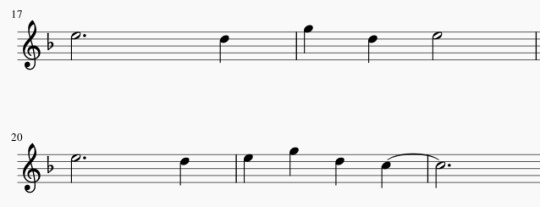
it keeps the first motif identical, takes out the first note of the second, and ties them together - except now it’s not open ended, now it knows where it’s going - it’s been three years, at this point bolin is confident in both himself and his bending
and then that phrase appears all over the place in the finale, because all bolin does is save people - everyone from the exploding building, he slows the giant mecha with lavabending, he saves opal, he slows the giant mecha again by collapsing a building on it, and most importantly, he’s the one rescuing his brother this time, instead of the other way around (though that one doesn’t get a motif appearance bc admittedly a fuck ton of other things are happening in the soundtrack at the time)
so to that question asked in book three - who is bolin when not next to someone else? well, funnily enough, we saw it in book two as well, just in a warped way, playing nuktuk. it just wasn’t truly him because it was created by varrick, and he needed to get away from varrick too. the question put forward by the narrative is who is bolin, and the answer given by the music is, he is a hero. and i don’t know why bolin is the only one to get a theme like this, but i think it may have something to do with the fact that, while everyone in team avatar has been a hero and saved people, he is the only one who has, from the start, solely been motivated by wanting to help people. he follows his heart, and his heart cares, about everyone. it’s been the driving force behind almost everything he’s ever done. and i love him so much
#so yeah those are my thoughts on bolin go forth and cry with me about five notes on a trumpet#legend of korra#lok#bolin#music
28 notes
·
View notes
Text
Chapter 4 – It is always 1895 [TAB 1/1]
TAB is my favourite episode of Sherlock. It is a masterpiece that investigates queerness, the canon and the psyche all within an hour and a half. Huge amounts of work has been done on this episode, however, so I’m not going to do a line by line breakdown – that could fill a small book. A great starting point for understanding the myriad of references in TAB is Rebekah’s three part video series on the episode, of which the first instalment can be found here X. I broadly agree with this analysis; what I’m going to do here, though, is place that analysis within the framework of EMP theory. As a result, as much as it pains me, this chapter won’t give a breakdown of carnation wallpaper or glass houses or any of those quietly woven references – we’re simply going in to how it plays into EMP theory.
Before digging into the episode, I want to take a brief diversion to talk about one of my favourite films, Mulholland Drive (2001).

If you haven’t seen Mulholland Drive, I really recommend it – it’s often cited as the best film of the last 20 years, and watching it really helps to see where TAB came from and the genre it’s operating in. David Lynch is one of the only directors to do the dream-exploration-of-the-psyche well, and I maintain that a lot of the fuckiness in the fourth series draws on Lynch. However, what I actually want to point out about Mulholland Drive is the structure of it, because I think it will help us understand TAB a little better. [If you don’t want spoilers for Mulholland Drive, skip the next paragraph.]
The similarities between these two are pretty straightforward; the most common reading of Mulholland Drive is that an actress commits suicide by overdose after causing the death of her ex-girlfriend, who has left her for a man, and that the first two-thirds of the film are her dream of an alternate scenario in which her girlfriend is saved. The last third of the film zooms in and out of ‘real life’, but at the end we see a surreal version of the actual overdose which suggests that this ‘real life’, too, has just been in her psyche. Sherlock dying and recognising that this may kill John is an integral part of TAB, and the relationships have clear parallels, but what is most interesting here is the structural similarity; two-thirds of the way through TAB, give or take, we have the jolt into reality, zoom in and out of it for a while and then have a fucky scene to finish with that suggests that everything is, in fact, still in our dying protagonist’s brain. Mulholland Drive’s ending is a lot sadder than TAB’s – the fact that, unlike Sherlock, there is no sequel can lead us to assume that Diane dies – and it’s also a lot more confusing; it’s often cited as one of the most complicated films ever made even just in terms of surface level plot, before getting into anything else, and it certainly took me a huge amount of time on Google before I could approach anything like a resolution on it!
Mulholland Drive is the defining film in terms of the navigating-the-surreal-psyche subgenre, and so the structural parallels between the two are significant – and definitely point to the idea that Sherlock hasn’t woken up at the end of TAB, which is important. But we don’t need to take this parallel as evidence; there’s plenty of that in the episode itself. Let’s jump in.
Emelia as Eurus

When we first meet Eurus in TST, she calls herself E; this initialism is a link to Moriarty, but it’s also a convenient link to other ‘E’ names. Lots of people have already commented on the aural echo of ‘Eros’ in ‘Eurus’, which is undeniable; the idea that there is something sexual hidden inside her name chimes beautifully with her representation of a sexual repression. The other important character to begin with E, however, is Emelia Ricoletti. The name ‘Emelia’ doesn’t come from ACD canon, and it’s an unorthodox spelling (Amelia would be far more common), suggesting that starting with an ‘E’ is a considered choice.
When TAB aired, we were preoccupied with Emelia as a Sherlock mirror, and it’s easy to see why; the visual parallels (curly black hair, pale skin) plus the parallel faked death down to the replacement body, which Mofftiss explicitly acknowledge in the episode. However, I don’t think that this reading is complete; rather, she foreshadows the Eurus that we meet in s4. The theme of ghosts links TAB with s4 very cleanly; TAB is about Emelia, but there is also a suggestion of the ghosts of one’s past with Sir Eustace as well as Sherlock’s own claims (‘the shadows that define our every sunny day’). Compare this to s4 – ‘ghosts from the past’ appears on pretty much every promotional blurb, and the word is used several times in relation to Eurus. If Eurus is the ghost from Sherlock’s past, the repressive part of his psyche that keeps popping back, Emelia is a lovely metaphor for this; she is quite literally the ghost version of Sherlock who won’t die.

What does it mean, then, when Jim and Emelia become one and the same in the scene where Jim wears the bride’s dress? We initially read this as Jim being the foil to Sherlock, his dark side, but I think it’s more complicated than this. Sherlock’s brain is using Emelia as a means of understanding Jim, but when we watch the episode it seems that they’ve actually merged. Jim wearing the veil of the bride is a good example of this, but I also invite you to rewatch the moment when John is spooked by the bride the night that Eustace dies; the do not forget me song has an undeniable South Dublin accent.* This is quite possibly Yasmine Akram [Janine] rather than Andrew Scott, of course, but let’s not forget that these characters are resolutely similar, and hearing Jim’s accent in a genderless whisper is a pretty clear way of inflecting him into the image of the bride. In addition to this, Eustace then has ‘Miss Me?’ written on his corpse, cementing the link to Moriarty.
[*the South Dublin accent is my accent, so although we hear a half-whispered song for all of five seconds, I’m pretty certain about this]
Jim’s merging with Emelia calls to mind for me what I think might be the most important visual of all of series 4 – Eurus and Jim’s Christmas meeting, where they dance in circles with the glass between them and seem to merge into each other. I do talk about this in a later chapter, but TLDR – if Jim represents John being in danger and Eurus represents decades of repressed gay trauma, this merging is what draws the trauma to the surface just as Jim’s help is what suddenly makes Eurus a problem. It is John’s being in danger which makes Sherlock’s trauma suddenly spike and rise – he has to confront this for the first time – just like Emelia Ricoletti’s case from 1895 only needs solving for the first time now that Jim is back.
At some point I want to do a drag in Sherlock meta, because I think there’s a lot more to it than meets the eye, but Jim in a bride’s dress does draw one obvious drag parallel for me.

If you haven’t seen the music video for I Want to Break Free, it’s 3 minutes long and glorious – and also, I think, reaps dividends when seen in terms of Sherlock. You can watch it here: X
Not only is it a great video, but for British people of Mofftiss’s age, it’s culturally iconic and not something that would be forgotten when choosing that song for Jim. Queen were intending to lampoon Coronation Street, a British soap, and already on the wrong side of America for Freddie Mercury’s unapologetic queerness, found themselves under fire from the American censors. Brian May says that no matter how many times he tried to explain Coronation Street to the Americans, they just didn’t get it. This was huge controversy at the time, but the video and the controversy around it also managed to cement I Want to Break Free as Queen’s most iconic queer number – despite not even being one of Mercury’s songs. There is no way that Steven Moffat, and even more so Mark Gatiss would not have an awareness of this in choosing this song for Moriarty. Applying any visual to this song is going to invite comparisons to the video – and inflecting a sense of drag here is far from inappropriate. Moriarty has been subsumed into Eurus in Sherlock’s brain – the male and the female are fused into an androgynous and implicitly therefore all-encompassing being. I’m not necessarily comfortable with the gendered aspect of this – genderbending is something we really only see in our villains here – but given this is about queer trauma, deliberately queering its form in this way is making what we’re seeing much more explicit.
Nothing new under the sun
“The thing that hath been, it is that which shall be; and that which is done is that which shall be done: and there is no new thing under the sun” (Ecclesiastes)
"Read it up -- you really should. There is nothing new under the sun. It has all been done before." (A Study in Scarlet, Sherlock Holmes)
“Hasn’t this all happened before? There’s nothing new under the sun.” (The Abominable Bride, Jim Moriarty)
This is arguably the key to spotting that TAB is a dream long before they tell us – when TAB’s case is early revealed to be a mixture between TRF (Emelia’s suicide) and TGG (the five pips), and we see the opening of ASiP repeated, we should be questioning what on earth is going on. This can also help us to recognise s4 as being EMP as well though – old motifs from the previous series keep repeating through the cases, like alarm bells ringing. Moriarty telling Sherlock that there is nothing new under the sun is his key to understanding that the Emelia case is meant to help him understand what happened to Jim, that it’s a mental allegory or mirror to help him parse it. This doesn’t go away when TAB ends! Moving into TST, one of the striking things is that cases are still repeating! The Six Thatchers appeared on John’s blog way back, before the fall – you can read it here: X. It’s about a gay love affair that ends in one participant killing the other. Take from that what you will, when John’s extramarital affection is making him suicidal and Sherlock comatose. Meanwhile, the title of The Final Problem refers to the story that was already covered in TRF and the phone situation with the girl on the plane references both ASiB and TGG, and the ending of TST is close to a rerun of HLV. It’s pretty much impossible to escape echoes of previous series in a way that is almost creepy, but we’ve already had this explained to us in TAB – none of this is real. It’s supposed to be explaining what is happening in the real world – and Mofftiss realised that this was going to be difficult to stomach, and so they included TAB as a kind of key to the rest of the EMP, which becomes much more complex.
However, if we want to go deeper we should look at where that quote comes from. I’ve given a few epigraphs to this section to show where the quote comes from – first the book of Ecclesiastes, then A Study in Scarlet. It’s one of the first things Holmes says and it is during his first deduction in Lauriston Gardens. This is where I’m going to dive pretty deep into the metatextual side of things, so bear with the weirdness.
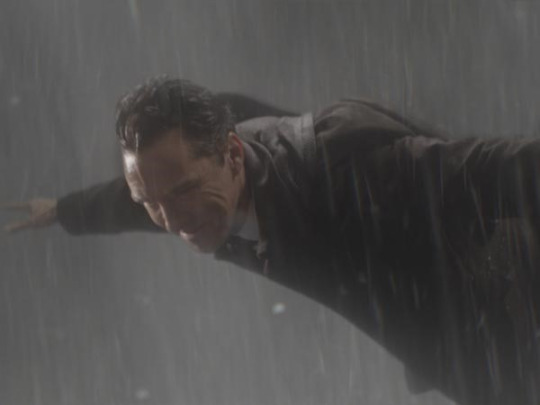
[we’re going deeper]
Holmes’s first deduction from A Study in Scarlet shows that he’s no great innovator – he simply notices things and spots patterns from things he has seen before. This is highlighted by the fact that he even makes this claim by quoting someone before him. If our Sherlock also makes deductions based on patterns from the past, extensive dream sequences where he works through past cases as mirrors for present ones makes perfect sense and draws very cleverly on canon. However, I think his spotting of patterns goes deeper than that. Sherlock Holmes has been repressed since the publication of A Study in Scarlet, through countless adaptations in literature and film. Plenty of these adaptations as well as the original stories are referenced in the EMP, not least by going back to 1895, the year that symbolises the era in which most of these adaptations are set. (If you don’t already know it, check out the poem 221B by Vincent Starrett, one of the myriad of reasons why the year 1895 is so significant.) My feeling is that these adaptations, which have layered on top of each other in the public consciousness to cement the image of Sherlock Holmes the deductive machine [which he’s not, sorry Conan Doyle estate] come to symbolise the 100+ years of repression that Sherlock himself has to fight through to come out of the EMP as his queer self.
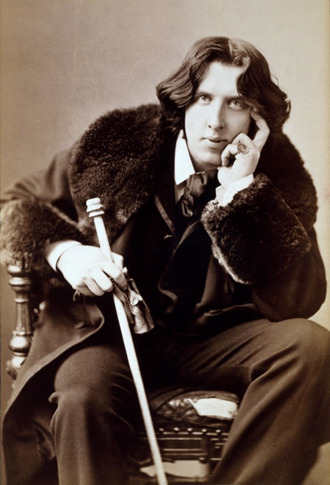
This is one of the reasons that the year 1895 is so important; it was the year of Oscar Wilde’s trial and imprisonment for gross indecency, and this is clearly a preoccupation of Sherlock’s consciousness in TFP with its constant Wilde references, suggesting that his MP’s choice of 1895 wasn’t coincidental. Much was made during TAB setlock of a newspaper that said ‘Heimish The Ideal Husband’, Hamish being John’s middle name and An Ideal Husband being one of Wilde’s plays. But the Vincent Starrett poem, although nostalgic and ostensibly lovely, for tjlcers and it seems for Sherlock himself symbolises something much more troubling. Do search up the full poem, but for now let’s look at the final couplet.
Here, though the world explode, these two survive
And it is always 1895
‘Though the world explode’ is a reference to WW1, which is coming in the final Sherlock Holmes story, and which is symbolised by Eurus – in other chapters, I explain why Eurus and WW1 are united under the concept of ‘winds of change’ in this show. Sherlock and John survive the winds of change – except they don’t move with them. Instead, they stay stuck in 1895, the year of ultimate repression. 2014!Sherlock going back in his head to 1895 and repeating how he met John suggests exactly that, that nothing has changed but the superficial, and that emotionally, he is still stuck in 1895.
Others have pulled out similar references to Holmes adaptations he has to push through in TAB – look at the way he talks in sign language to Wilder, which can only be a reference to Billy Wilder, director of TPLoSH, the only queer Holmes film, and a film which was forced to speak through coding because of the Conan Doyle estate. That film is also referenced by Eurus giving Sherlock a Stradivarius, which is a gift given to him in TPLoSH in exchange for feigning heterosexuality. Eurus is coded as Sherlock’s repression, and citing a repressive moment in a queer film as her first action when she meets Sherlock is another engagement by Sherlock’s psyche with his own cinematic history. My favourite metatextual moment of this nature, however, is the final scene of TFP which sees John and Sherlock running out of a building called Rathbone Place.

Basil Rathbone is one of the most iconic Sherlock Holmes actors on film, and Benedict’s costume in TAB and in particular the big overcoat look are very reminiscent of Rathbone.


Others have discussed (X) how the Victorian costume and the continued use of the deerstalker in the present day are images of Sherlock’s public façade and exclusion of queerness from his identity. It’s true that pretty much every Holmes adaptation has used the deerstalker, but the strong Rathbone vibes that come from Ben’s TAB costume ties the 1895 vibe very strongly into Rathbone. To have the final scene – and hopefully exit from the EMP – tie in with Sherlock and John running out of Rathbone Place tells us that, just as Sherlock cast off the deerstalker at the end of TAB (!), he has also cast off the iconic filmic Holmes persona which has never been true to his actual identity.
Waterfall scene
The symbol of water runs through TAB as well as s4 – others have written fantastic meta on why water represents Sherlock’s subconscious (X), but I want to give a brief outline. It first appears with the word ‘deeper’ which keeps reappearing, which then reaches a climax in the waterfall scene. The idea that Sherlock could drown in the waters of his mind is something that Moriarty explicitly references, suggesting that Sherlock could be ‘buried in his own Mind Palace’. The ‘deep waters’ line keeps repeating through series 4, and I just want to give the notorious promo photo from s4 which confirms the significance of the motif.

This is purely symbolic – it never happens in the show. Water increases in significance throughout – think of Sherlock thinking he’s going mad in his mind as he is suspended over the Thames, or the utterly nonsensical placement of Sherrinford in the middle of the ocean – the deepest waters of Sherlock’s mind. Much like the repetition of cases hinting that EMP continues, the use of water is something that appears in the MP, and it sticks around from TAB onwards, a real sign that we’re going deeper and deeper. I talk about this more in the bit on TFP, but the good news is that Sherrinford is the most remote place they could find in the ocean – that’s the deepest we’re going. After that, we’re coming out (of the mind).
Shortly after TAB aired, I wrote a meta about the waterfall scene, some of which I now disagree with, but the core framework still stands – it did not, of course, bank on EMP theory. You can find it here (X), but I want to reiterate the basic framework, because it still makes a lot of sense. Jim represents the fear of John’s suicide, and Jim can only be defeated by Sherlock and John together, not one alone – and crucially, calling each other by first names, which would have been very intimate in the Victorian era. After Jim is “killed”, we have Sherlock’s fall. The concept of a fall (as in IOU a fall) has long been linked with falling in love in tjlc. Sherlock tells John that it’s not the fall that kills you, it’s the landing, something that Jim has been suggesting to him for a while. What is the landing, then? Well, Sherlock Holmes fell in love back in the Victorian era, symbolised by the ultra repressive 1895, and that’s where he jumps from – but he lands in the 21st century. Falling in love won’t kill him in the modern day. What I missed that time around, of course, was that despite breaking through the initial Victorian layers of repression, he still dives into more water, and when the plane lands, it still lands in his MP, just in a mental state where the punishment his psyche deals him for homosexuality is less severe. This also sets up s4 as specifically dealing with the problem of the fall – Sherlock jumps to the 21st century specifically to deal with the consequences of his romantic and sexual feelings. There’s a parallel here with Mofftiss time jumping; back when they made A Study in Twink in 2009, there was a reason they made the time jump. Having Sherlock’s psyche have that touch of self-awareness helps to illustrate why they made a similar jump, also dealing with the weight of previous adaptations.
Women
I preface this by saying how incredibly uncomfortable I find the positioning of women as the KKK in TAB. It’s a parallel which is unforgivable; frankly, invoking the KKK without interrogating the whiteness of the show or even mentioning race is unacceptable. Steven Moffat’s ability to write women has consistently been proven to be nil, but this is a new low. However, the presence of women in TAB is vital, so on we go.

TAB specifically deals with the question of those excluded from a Victorian narrative. This is specifically tied into to those who are excluded from the stories, such as Jane and Mrs. Hudson. Mrs. Hudson’s complaint is in the same scene as John telling her and Sherlock to blame the problems on the illustrator. This ties back to the deerstalker metaphor which is so prevalent in this episode; something that’s not in the stories at all, but a façade by which Holmes is universally recognised and which as previously referenced masks his queerness. Women, then, are not the only people being excluded from the narrative. When Mycroft tells us that the women have to win, he’s also talking about queer people. This is a war that we must lose.
I don’t think the importance of Molly in particular here has been mentioned before, but forgive me if I’m retreading old ground. However, Molly always has importance in Sherlock as a John mirror, and just because she is dressed as a man here doesn’t mean we should disregard this. If anything, her ridiculous moustache is as silly as John’s here! Molly, although really a member of the resistance, is able to pass in the world she moves in in 1895, but only by masking her own identity. This is exactly what happens to John in the Victorian era – as a bisexual man married to a woman, he is able to pass, but it is not his true identity. More than that, Molly is a member of the resistance, suggesting not just that John is queer but that he’s aware of it and actively looking for it to change.
I know I was joking about Molly and John’s moustaches, but putting such a silly moustache on Molly links to the silliness of John’s moustaches, which only appear when he’s engaged to a woman and in the Victorian era. He has also grown the moustache just so the illustrator will recognise him, and Molly has grown her moustache so that she will be recognised as a man. In this case, Molly is here to demonstrate the fact that John is passing, but only ever passing. Furthermore, Molly, who is normally the kindest person in the whole show, is bitter and angry throughout TAB – it’s not difficult to see then how hiding one’s identity can affect one’s mental health. I really do think that John is a lot more abrasive in TAB than he is in the rest of the show, but that’s not the whole story. Showing how repression can completely impair one’s personality also points to the suicidal impulses that are lurking just out of sight throughout TAB – this is what Sherlock is terrified of, and again his brain is warning him just what it is that is causing John this much pain and uncharacteristic distress.
This is just about the loosest sketch of TAB that could exist! But TAB meta has been so extensive that going over it seems futile, or else too grand a project within a short chapter. Certain theories are still formulating, and may appear at a later date! But what this chapter (I hope) has achieved has set up the patterns that we’re going to see play out in s4 – between the metatextuality, the waters of the mind and the role of Moriarty in the psyche, we can use TAB as a key with which to read s4. I like to think of it as a gift from Mofftiss, knowing just how cryptic s4 would be – and these are the basic clues with which to solve it.
That’s it for TAB, at least in this series – next up we’re going ever deeper, to find out exactly who is Eurus. See you then?
#tjlc#emp theory#thewatsonbeekeepers#my meta#meta#mine#chapter four: it is always 1895#vincent starrett#mofftiss#1895#bbc sherlock#johnlock#tjlc is real
79 notes
·
View notes
Text
musical continuity and the Greetings (ごあいさつ) leitmotif
i wrote this 2 weeks ago I was originally going to make a post about the main motif first (y’all know the one) and then talk about Greetings later, but then 4.24 aired and,, well here we are
Greetings (the track) first shows up in 3.01 when Kageyama and Hinata display their quick before the Shiratorizawa match. It’s a badass introduction. It’s cool. The music is tied to this display of new ability, and it returns when Hinata saves Kageyama’s weak toss by hitting his left hand, winning them the set (3.06), as everyone is, again, introduced to something new.
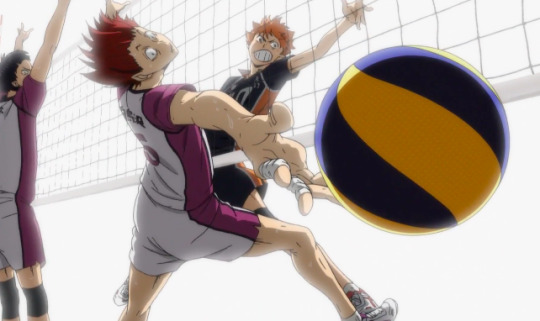
((this track might as well be called “someone does some cool shit for the first time and everyone loses their minds”))
All of this, what’s been previously set up, is subverted in 4.09. Kageyama hits a solid serve as we hear the build-up brass, then there’s Hinata’s run-up to spike. They’re both confident. We already associate Greetings with this triumphant entrance, proven three times before (the quick, the left-hand hit, and Tsukishima’s return in 3.08) — and so the music hammers home that expectation: Hinata is going to score the point.
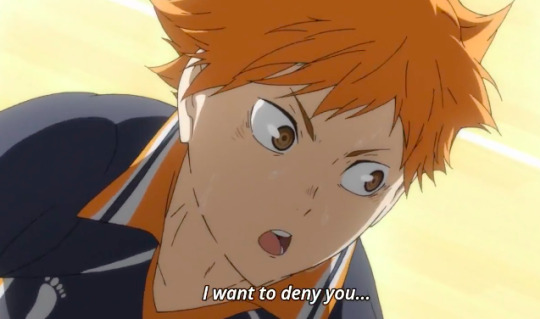
Except he doesn’t.
In this context, Hinata is denied the triumph of Greetings. As Shiratorizawa denies Hinata within the narrative, they’ve also co-opted the theme, denying Karasuno (and us) at a meta/music level. (ps I’m very sorry for using the words “meta-music”)
I think Greetings takes on a bit of a different meaning after this moment, especially because the next time it’s heard is when Hinata says “I’m glad I came here” in 4.12.
SO guess where we hear it in 4.24? Right after Asahi’s spike! Not during that big moment, but after, when Futakuchi’s explaining how Asahi practised and perfected the move. I saw this as a subtle change from its use in S3, because here it wasn’t Asahi adapting in the spur of the moment, it was the result of seasons worth of behind-the-scenes practice. The fact that Greetings plays over not the act, but the acknowledgement of it makes it not a “big” moment in terms of commentators/spectators going wild, but a big moment that’s testament to the team’s growth. As Daichi says, they don’t need a miracle, and as Tsukishima says at the end of the episode, the team isn’t surprised: because they’ve worked hard and trained.
Now here’s the other fun part. Technically, we hear Greetings a second time in 4.24. It’s a completely new track, but the Greetings leitmotif is unmistakable. It begins right here, with the first connection in the long volley:

Just as in s3, the familiar melody comes in anticipation of triumph. But despite the familiar leitmotif, the instrumentation and tempo (overall tempo increases by at least 10 bpm) have changed. Something about it is off. This is felt even more because Greetings itself has already been used in this episode.
hear me out, Greetings goes like this:
starts with the french horn
then the melody is taken over by strings
you hear spiccato on low strings (those bouncing, short notes)
the electric guitar comes in to support them, before backing away
for the vocals to come in together with the strings.
The leitmotif in this new track begins with strings, so that’s recognisable, but the instrumentation of the second phrase is scored for trumpets. The trumpets are accompanied directly with this shot:
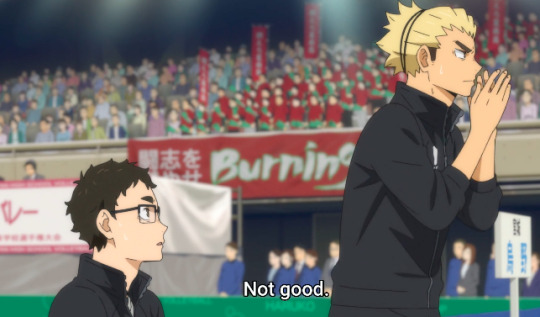
I really like the dissonance here, between the expectations the grand Greetings motif carries and Ukai’s worried expression. And as the characters’ pace picks up, the part which would have been the spiccato strings is no longer measured, but panicked and frenetic; the tempo is quicker than in Greetings, and now played by the electric guitar. The electric guitar, instead of having that give-and-take with the strings (in Greetings), fights with the strings and heavy percussion:
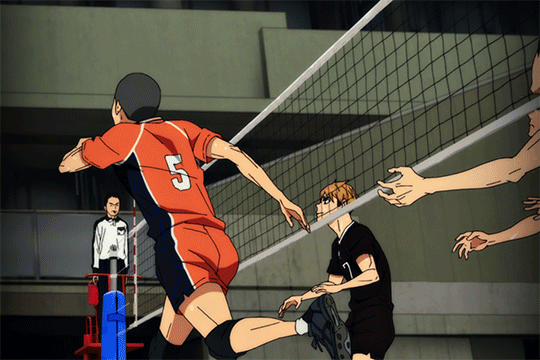
Eventually, instead of the choir vocals, arguably the most triumphant part that ends the track, the leitmotif melds into a completely new orchestration. At a musical level, the triumph is essentially slipping away from their grasp into unfamiliar melodic territory. Especially since this is the first time this leitmotif has been used outside of Greetings and i’m so here for it
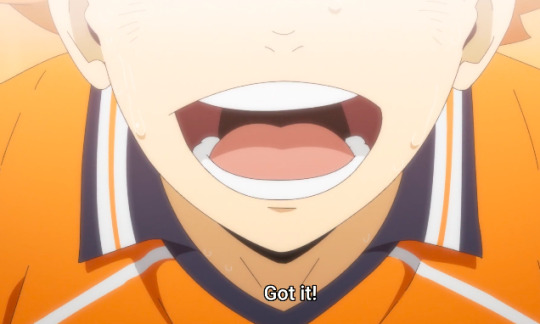
Then the music stops entirely. And even though the leitmotif cuts off, the circumstances end in triumph: Hinata saves it, almost as though he’s evolved past/overcome the music. And he does this with a simple receive, in a way that isn’t showy or immediately cool.
side note, I think it’s very interesting that Greetings is written in the same key as the main leitmotif. coincidence? i think not
I feel like very often, how scores are used is rather straightforward. Just look at any Marvel film: what you see hear is what you get. Emotional moment = slap some high strings on it. Battle scene = electric guitar/brass. Exposition scene = quiet, generic synth music that practically fades into the background. The music serves an entirely functional purpose: reflects the relevant emotions of that particular scene to fill in what would otherwise be awkward silence. It’s less a score and more just background music.
What makes a show’s score stand out (imo) is musical continuity. There’s awareness of the music in relation to not the moment in isolation, but the story. ((i’m just gonna plug les misérables, it’s done so well; take just one of many examples, with Valjean and Javert: narrative foils, each have an iconic solo with virtually identical music in What Have I Done vs. Javert’s Suicide.))
So as much as the music in hq!! slaps, I’m even more delighted that the score is actually being well-utilised. Don’t get me wrong, not everything has to have some huge narrative significance, and some track choices are probably just for fun (or maybe occasionally odd, but it doesn’t happen often), but for the most part, when it matters, it’s done right.
#i uhh. may or may not have transcribed the melody for this track#to compare to the main motif#which i will have to make a separate post for bc this is getting too long#local lit student never shuts up.txt#hinata shouyou#inarizaki#haikyuu to the top#hq!! meta#haikyuu meta#marc.txt#*mine#long post
23 notes
·
View notes
Text
another of my favourite things about 1917 is how well the soundtrack ties into what’s happening on screen. because in other films, it’s very easy and very common for the soundtrack to become nothing more than background music - it plays under the scene, it might have one particularly grand moment during a final battle or pivotal bit, but for the most part, it’s just there to fill the silence and add a bit of ambience.
but in 1917, it’s more like ballet, or live theatre, or, actually, very much like fan edits - because, all through the film, there are beats that fall on specific pieces of action, like when scho slams bäumer against the column and there’s the thud built into the music. and that is so satisfying.
and even more than being satisfying as a viewing experience to have the music perfectly align with what we’re seeing, it makes it even more immersive when you’re listening to the soundtrack by itself - because it’s so synced with the visuals, you know precisely what is happening even when you haven’t got the film in front of you. in “the night window”, you know exactly when scho begins to run from the rifle fire. in “engländer”, you know exactly when müller stumbles out of the ruined school and throws up, and you know exactly when bäumer stops breathing, and when scho starts to run, and when he breaks free of the maze of rubble and starts along that long stretch of open road, and when he makes the jump from the bridge. in “sixteen hundred men”, you know exactly when he starts and ends his run, and when he rolls back down into the trench. in “gehenna”, you know exactly when they’re beginning to approach the german frontline, and you know when they finally arrive at it and aim their rifles down the trench. in “come home to us”, you know exactly when scho closes his eyes.
and then, even more than that, there are times when you don’t even realise there’s any music playing at all, when it just sounds like your own heartbeat or the sound of distant war - when it somehow manages to sound like tense silence. it took my mum six viewings in the cinema and me pointing it out for her to even realise that there was music throughout the entire film - because so much of it blends in with what’s happening on screen so fluently that it just disappears. hell, there’s even the sound of distant explosions, rumbling, and plane propellers built into “milk”! “écoust saint mein” has a heartbeat thudding in the background! you feel afraid and nervous and you don’t even know why.
and so much of the musical cues echo what the characters are feeling - so you end up with these moments in the music that are almost tangible, that portray emotion in a way that cuts deeper and is more personal and recognisable to the audience than just seeing it can be: the panicked violin strings after scho kills bäumer in “engländer”, that are like scho’s whirlwind of thoughts given a voice; the fact that from 2:05 onwards, “the night window” feels like howling, like wailing, like everything scho isn’t able to do and process in that moment - it feels like sweeping grief, like just screaming yourself raw to the night sky, like a slow build-up of misery and sorrow and fear and anger into a final blinding, unhinged outburst, because that’s what that run is: more than just running for his life, it’s running blind into this concussed, swirling landscape where nothing makes sense and where he’s alone and lost and grieving, and finally he feels. and then it quietly settles down into something tidy and contained again because schofield can’t let himself collapse.
and also!! just - the way even the happier and prettier sounding music always descend into tense, unsettling endings, because there’s no such thing as peace in this film and there’s always danger and trauma lurking around the corner, and when it isn’t physical it’s still in their minds. like that horrible, high-pitched, vibrating rumble in “mentions in dispatches” before the mission is even revealed. it is so unsettling - because that’s how they feel. always. constantly. and thomas newman wasn’t afraid to make some of the tracks almost impossible to listen to, like “tripwire” - because they aren’t meant to be listened to, they aren’t meant to be artful and nice, they’re meant to be experienced, felt, lived. and the way that “a bit of tin” isn’t some sweeping, sorrowful track - it’s just quiet, and subdued, and bleak, and empty, because that’s what blake’s death has done to schofield. it isn’t wild, soaring grief like it later becomes in “the night window”; it’s just... quiet. and the way the introduction to the film and to blake and schofield, the way their title track, is just... so unsettled. so sparse and mournful. so tired. it isn’t the sympathetic theme of drained heroes. it isn’t the grand and joyous tribute to soldiers who have done their duty. it’s just bleak - even with blake, it’s just bleak: even if he isn’t like schofield now, this introduction promises that it’s just a matter of time, and the war is chipping away at him piece by piece as well, and as the track descends lower and lower near the end, that’s what he would have become if he’d survived. he was probably so much more when he first arrived, too. the warm, cheery, naïve blake that we meet, this introduction promises, is still a pale ghost compared to the boy he was a few months ago.
and it’s brilliant. because it goes beyond just a visual experience - the music has become the film in and of itself. and it’s spectacular as well because it may not have one outstanding score that’s become so iconic that it can be hummed and everyone will know it in an instant - it hasn’t got a song like the star wars or jurassic park or mission impossible themes. the entire soundtrack is the film and the recurring motifs are so subtle that you hardly even realise you’ve started to recognise and expect them. and i just love it so, so much. it is such a truly, deeply beautiful soundtrack that is so revolutionary for a war film and i could wax poetic about it for hours.
#mine#1917#FUCK i love this soundtrack#it literally makes me cry like the night window????? WHO thought to use#a piece of music that could be in a ballet for a scene where a soldier is running from gunfire#WHO chose to make it emotional and beautiful and tender and SAD???#I LOVE IT#so much of that track sounds like the 1812 overture - the destruction and loss of the motherland - and i am broken over it
112 notes
·
View notes
Note
Okay remember that colour page with Emma hanging on to some kind of bridge-like thing with Conny's bunny on her other hand? Yeah. I just realised if you flip the page upside down you can see a gate AND THERE ARE TINY HUMANS HANGING ON TO IT/CLIMBING IT?!??!?! PLEASE EXPAND YOUR THOUGHTS ON THIS and how THis is similar to the colour page with the staircase and Gilda being upside down
Let me answer your question with my newest theory on the
Alice in Wonderland Motifs in The Promised Neverland
Prepare yourself for a wild ride here. You will most likely get mindblown and think “why didn’t I think of this before?!”. This had all been there right from the start, and none (as far as I know) noticed…So let me start this off with a little summary of how Alice in Wonderland begins:

Alice was living a carefree, but (peacefully) dull life until one day her world was turned upside down when she decided to chase after a white rabbit with a pocket watch. Hmmm hmm, didn’t I say in my previous post on Gracefield items that there was a bit more to the “pocket watch” than just it being a tracker? Oh yeah, because we DO. HAVE. A. WHITE. RABBIT.
Oh, yeah, and the whole bloody adventure started because of it!

You may cry coincidence here even if you notice the glaringly obvious watch on the neck of Little Bunny (or its posh waistcoat…), so let me continue on.So remember that I also said before that Carol’s name had some importance? Or that Alicia’s stuffed toy was noted also for a reason? Well, you know who wrote Alice in Wonderland?
LEWIS CARROLL!!Are you (mentally) screaming yet? No? Okay, so remember that Alicia’s toy is a cat? Well, you should also remember that Alice’s favourite pet was a cat as well.

But you know, these are just some odd references so far, so how about we look at some other characters? Like… doesn’t Lewis kind of ring a bell to you? Hm, what was so distinctive about him again? Well, he was a bit crazy, but you could always recognise him from his HAT, RIGHT?
Correct me if I’m wrong, but didn’t Alice in Wonderland have someone called the MAD HATTER?!
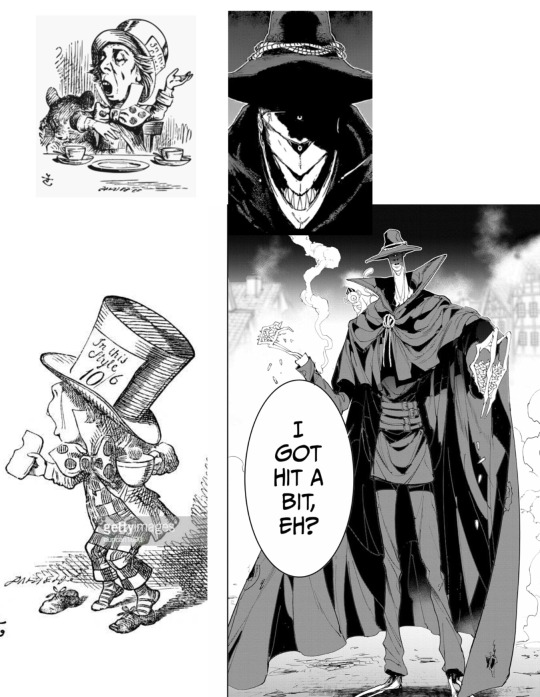
Also, remember the Mad Hatter’s teaparty? It was one heck of a chaos, but what about his friends that he happily shared his tea with (note that in the original British language version tea can also mean lunch/dinner)? The March Hare (not to be confused with the White Rabbit) and the Dormouse. Isn’t it interesting that our hat wearing Leuvis was so close with Lord Bayon and the little Parvus?
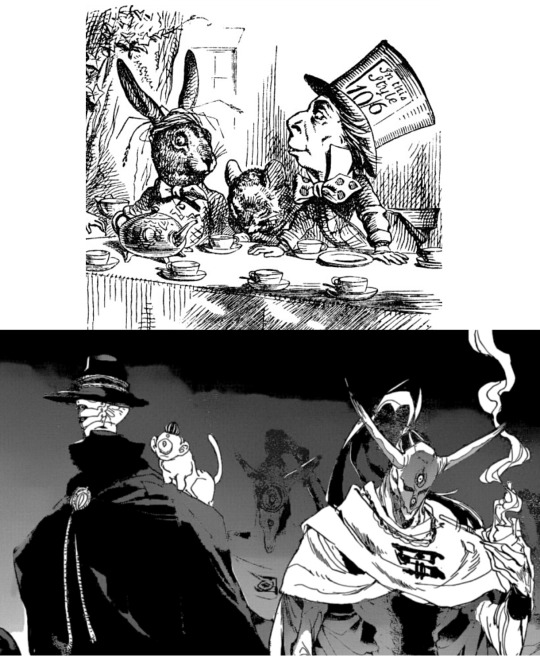
Haha, I hope now you can’t get the image of Bayon with bunny ears out of your head either!.Actually, you know what, wasn’t Alice’s Wonderland kind of a messed up place and experience for her? Even though it was meant to be her happy place? Hm, isn’t that a little bit like the Goldy Pond experience? I have always thought it looked like a creepy theme park tbh.
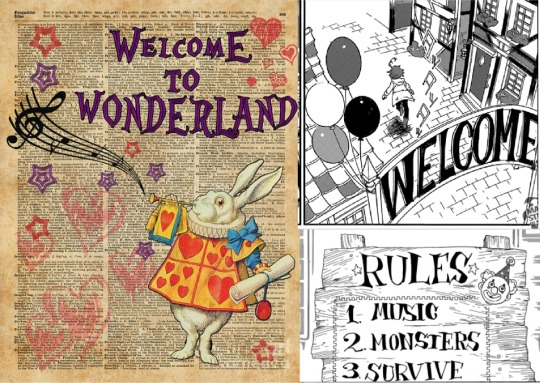
But if you think I am going to stop here, you are wrong… because we haven’t talked about the Cheshire Cat yet! This confusing creature was the first thing that Alice had an intelligent conversation with, and he also explained the rules of Wonderland to Alice. Wasn’t that nice of him? Kinda a bit like how Son-ju explained about the Promise to Emma, no? How about the Cheshire Cat’s grin? Didn’t Son-ju have a nice, toothy grin? Also, kind of a fluffy mane if you ask me.

GUYS HAVE YOU NOTICED THAT SON-JU HAS TABBY STRIPES?! I am so done in by laughing about that!.Lets not forget however the first being that helped Alice in Wonderland: the Caterpillar. Alice was at first suspicious of it, and a bit rude, but eventually she figured out that the caterpillar was just pretty nice and helpful to her. Oh right, I seem to recall Emma being a bit suspicious of Mujika at first, but then receiving some pretty handy advice and help from her!

At this stage, the visual resemblances are not even subtle, right?.
However, let me admit that I have only had an eureka moment after reading chapter 132, and noticing this resemblance:

The situation is a bit unclear to me if Legravalima is meant to be the Red Queen or the Queen of Hearts. These two characters are separate, and often get confused, see the explanation here:
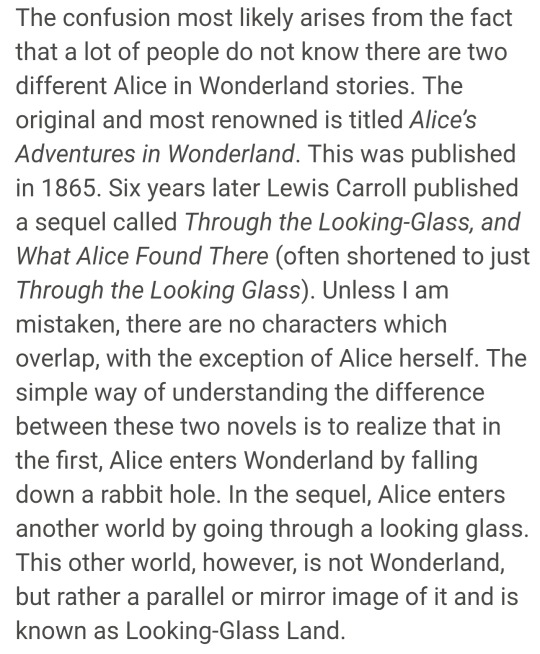

The Queen of Hearts was shown to be a quick to anger, passionate person. Since we see Legravalima’s hair resemble a rose, she may be a reference to the Queen of Hearts, who had people’s heads chopped off for painting roses red. However, Legravalima also acts cooly, and the Red Queen is a lot more like that. While the Queen of Hearts was a card, the Red Queen was a chess piece. With all the recent chess images, I am reminded of the following:

However, I haven’t yet answered the original question about that colourspread. Well, the answer is very simple actually.
It’s the Rabbit Hole that Alice falls down in.
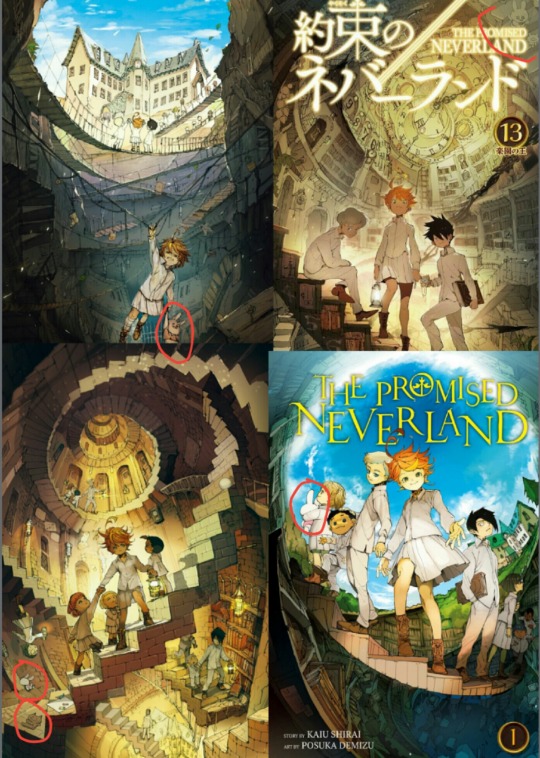
Just in case you missed it, I have included a couple more connected images, and have circled Little Bunny on each and every one of them (you can also see Carol’s doll on some of those). Yepp, it is the rabbit hole. It’s the tunnel that leads to a different world in Alice in Wonderland, and so it is in the Promised Neverland.In response to your previous questions about the well in Gracefield’s yard, in Alice in Wonderland, the rabbit hole leads to what is described as a “really really deep well”. So this may be the other significance of the well.Since I was unable to finish this post before the spoilers dropped for chapter 133, you can find my thoughts on them, and how they fit if you read below the cut
So in chapter 132 we entered the Seven Walls, and it looks like we are finally in for a full Alice in Wonderland trippy experience in chapter 133! I kind of knew as soon as I saw Gracefield, as my previous theories have connected it to the tunnel.There are two motifs that instantly strike out at me: Emma falling, and Ray being shrunk down. Both of these things happen to Alice as well.

The chapter ends with Emma and Ray staring down a hole to a pantry. This actually seems like the rabbit hole proper to me. The Alice in Wonderland novel describes the rabbit hole having endless shelves and cupboards on the walls with various things on them. It is noted that Alice takes a jar of marmalade from a shelf, then places it back to another while she falls. I wouldn’t be surprised to see some marmalade in chapter 134 after all of this now!
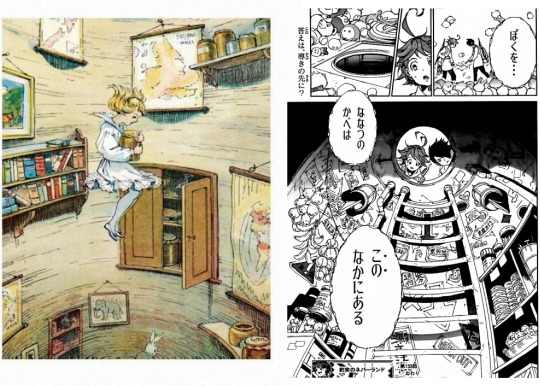
So yepp, let’s see our kids fall down the rabbit hole in chapter 134!
The interesting thing to note about Alice in Wonderland is that Wonderland is all imagined by Alice. That seems to be just like my theory on demon!God using its powers of imagination to create the demon world! ;D
Ok, that’s it folks for today, hope you enjoyed it!
#alice in wonderland#tpn#yakusoku no neverland#tpn spoilers#the promised neverland#tpn theory#tpn emma#tpn little bunny#tpn alice in neverland#tpn ray#tpn 132#I bet you didn't think#that I could pull another reference like this#I have zero doubts on this one#it's very obvious#once you figure it out#can't believe I didn't realize#until now
1K notes
·
View notes
Text
Black Swan bookgasm review #2: Growth of the Soil by Knut Hamsun (1917)
It is not uncommon for a writer to become more known for his reputation than actual work. Not that the work isn’t of quality, just that it is easier for the public to fixate on their extreme political beliefs or their tragic life than for the very work that writer should be known. Sylvia Plath is a perfect example, since many non-readers of poetry are aware of her taking her own life by sticking her head in an oven, yet are unfamiliar with her great poetry - the very thing for which she is deservedly celebrated. Such is the same fate of the Norwegian writer Knut Hamsun who was well known in his day, for he won the Nobel Prize for literature in 1920 after having published Growth of the Soil in 1917.
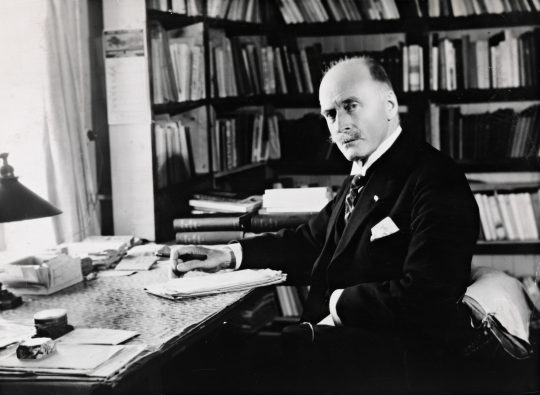
In the same way the French have come to wrestle with acknowledging the literary greatness Louis Ferdinand Celine’s in tension with Celine’s Nazi sympathies during World War Two - so Norway has had its own ‘Celine’ problem with Knut Hamsun. Hamsun was well known for having been a Nazi sympathiser, and upon winning the Nobel, he apparently mailed his medal to one of Hitler’s closest associates, Joseph Goebbels. Then, after Hitler’s death, sources claim that he made some sorrowful eulogy, lamenting over the dictator’s life and death. As result, readers have adopted ambivalent feelings for the write - hating him for his politics yet loving him for his work. It should be also noted that Hamsun was in ‘mental decline’ after the war, so one can’t be sure what he would have believed in a healthier state of mind. But all this should be no matter, for what counts is the work, and Growth of the Soil is a work worth the read.
Hamsun had his admirers in the literary world including H.G. Wells who wrote, “I do not know how to express the admiration I feel for this wonderful book without seeming to be extravagant. I am not usually lavish with my praise, but indeed the book impresses me as among the very greatest novels I have ever read. It is wholly beautiful; it is saturated with wisdom and humour and tenderness."

Though the novel’s setting is in rural Norway, civilisation and its discontents are never far off. There are telegraphs and newspapers. People read. It's not as though this is a bucolic idyll in a sheltered Eden. It is a novel full of contrasts - most obviously between the remote, traditional agrarian life and the rapidly encroaching modern world. This is a very typical Norwegian subject—and typical for many small countries that have gone through such dramatic changes in just a generation or three. Nostalgia looms large.
The book tells the story of Isak and Inger, a married couple seeking to make a living off land that many believe to be a bad business move. We begin with Isak's first steps to create a home in the Norwegian wilds: 'The wilderness was inhabited and unrecognisable, a blessing had come upon it, life had arisen there from a long dream, human creatures lived there, children played about the houses. And the forest stretched away, big and kindly, right up to the blue heights.' He finds a woman, Inger, initially a simple soul, whom life gradually makes more complex. Inger is physically disfigured, but Isak is devoted to her, and the couple works to raise a family and make a life off their land, furrow by furrow, ax blow by ax blow, grows a life. He is the first, the trailblazer.
Gradually other settlers move in - the idle, the industrious, the promiscuous - creating over decades a community of sorts. This includes the self-seeking Oline, “Never in life would she give in and never her match for turning and twisting heaven and earth to a medley of seeming kindness and malice, poison and senseless words.” One of the most enigmatic characters is Geissler, originally introduced as a decent official with whom Isak has dealings; he helps him at other times and made me wonder if Hamsun was equating him to some Viking deity, “I’m something, I'm the fog as it were, here and there, floating around, sometimes coming like rain on dry ground... There's my son, the lightening.” Years later, men come for the stringing of telegraph wires, the mining of ore in the adjacent mountains. Hamsun presents the incursion of man into nature, the imposition of will on a pristine Nordic first world.
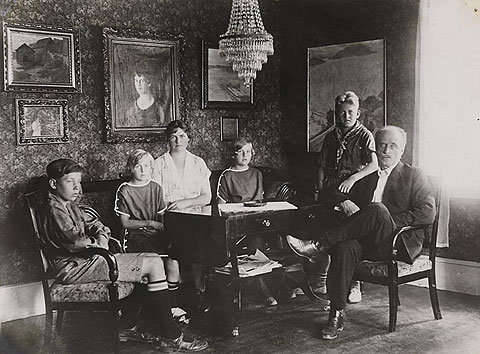
There's a ‘worldly’ balance to the drama, yet Isak's simple virtues prevail - although he's constantly challenged by events, some beyond his control. There, to a degree, he's protected by his guardian angel of a friend, Geissler, a man as complex and mysterious as Isak is simple - but a man equally as virtuous.
Hamsun’s lovely prose pulls the reader into this pioneer ethic where you rejoice which the construction of a new hay loft and dismiss with contempt the inept farmer who sees to his own comfort before that of his stock. On more than one occasion our protagonists easily reject the offer of a few days’ work for ready cash to tend to the more pressing business of hay that needs cutting or timber that needs hauling, much to the puzzlement of the befuddled capitalists in search of local labour.
Many a Scandinavian will recognise Isak’s inscrutable personality, his lack of expression, his need for time to consider a change. And while Isak plods on in life, prospering by the virtues of hard, unceasing labour, those gathered around him demonstrate every other variation of humanity. There’s the flighty and the money-grabbing, the gossip and the fearful… all stand in contrast to his unerring purpose. By the end of the tale our lone walker has become a wealthy and well-respected margrave, patriarch of the richest farm at the heart of a growing agricultural community, whilst the more speculative endeavours of mining and commerce have boomed and busted around him.
The novel is full of biblical motifs from the Old Testament but it’s not a religious themed story. Rather the book is somewhat critical of city life and culture, especially when it threatens the preservation of land and family values. Hamsun’s far right roots poke through at times with his attitude toward the indigenous Lapps, “maggots”, and fairly non-stop jabs at the less than intellectual bent of the otherwise admirable peasantry.
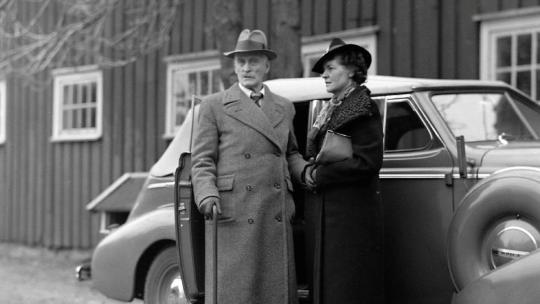
Hamsun convincingly writes of a beautiful celebration of the rural life: “Nothing growing there? All things growing there; men and beasts and fruit of the soil. Isak sowing his corn. The evening sunlight falls on the corn that flashes out in an arc from his hand and falls like a dropping of gold to the ground. Here comes Sivert to the harrowing...Forest and field look on. All is majesty and power - a sequence and purpose of things.” One of the most fascinating aspects of the story was the prevalence of infanticide in Norwegian rural culture (the extent of which is truly shocking as much as it is known by Norwegians today).
Although Hamsun is never preachy, the lure of the city is something that recurs throughout the tale, and although the city itself is not something shown to be evil, it is more or less, just like the rough parts of nature: indifferent to human happiness and fulfilment. And in some sense, the imposition it can cause is inescapable. Though when asked which will outlast, land will always live without the need for humans, for the city is nothing more than peopled wilderness, or: “the wilderness was peopled country now.” Without the people, the wilderness will always return.
Growth of the Soil becomes the growth of generations - the passage of time and the growth of land that makes its way within the creases of one’s face and hands. The people become their land, and by the end of the novel, Isak is balding, and what the narrator calls “a stump of a man.” He is older and not as physically strong as he once was, but he is not beaten. He continues sowing his grain. “Growth of the soil was something different, a thing to be procured at any cost; the only source, the origin of all.” Later this point is expounded further: “’Tis not all that are so, but you are so; needful of earth. ‘Tis you that maintain life. Generation to generation, breeding ever anew; and when you die, the new stock goes on. That’s the meaning of eternal life.”
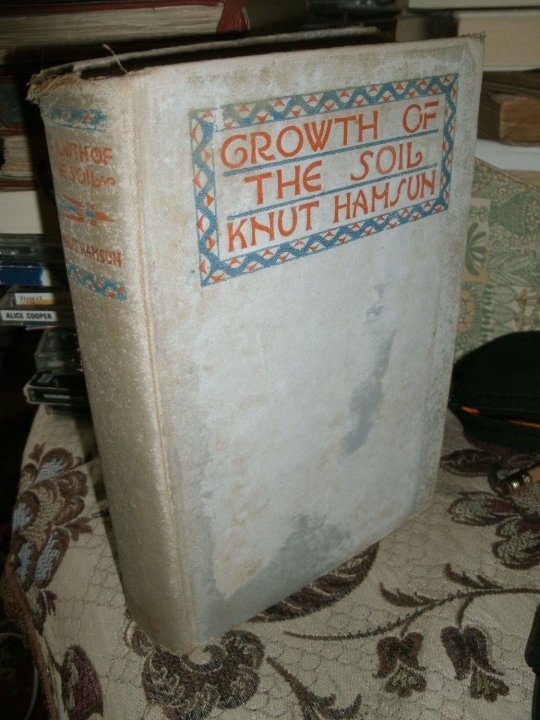
In many ways, reading Growth of the Soil is like reading a preview for the later great writers, for one can see American writers like John Steinbeck and Thomas Wolfe have picked amid the themes in this work and made them their own. Yet there are moments when Growth of the Soil can feel a bit verbose for the impatient reader. Yet Hamsun is worth reading because there is no way around him. In the same way what Louis Ferdinand Celine did for French literature, Hamsun tore apart both the grammar and the lexicon of our Norwegian language, mixed high and low, dialect and aristocratic speech, and put all the pieces beautifully together again - in the totally new fashion we call contemporary Norwegian literature. As every Russian writer is rolled out of Gogol’s coat, every Norwegian one is an offspring of Hamsun, admittedly or otherwise.
One can wonder how the story of Norwegian peasants in the 19th century can be relevant today? But as we live so far removed from nature, are so surrounded by words and noise (mostly meaningless) and spend so much time worrying about our psyches, "Growth of the Soil" provides the exact antithesis of our world. It provides a perspective of what is really necessary for life and contentment and what needs to be let go of and what needs to be retained. It is a simple story of simple people, but it is far from shallow. The writing is beautiful and conveys so well the nuances of relationships and the impact of nature on humanity. In all, this is a a very Scandinavian work. Like an iconic Viking ship which combines beauty and simplicity with function, and is capable of navigating both rough seas and shallow rivers, Hamsun's writing has a biblical simplicity that narrates elegantly both life's small and meaningful events as well as its epic arc.
#book review#book#reading#bookgasm#literature#norwegian#norsk#personal#knut hamsun#growth of the soil#novel
25 notes
·
View notes
Text
My HTTYD3 Review *SPOILERS*
First of all: I ADORED IT! It was a wonderful ending to the best trilogy of films I have ever seen. I started this journey with DreamWorks in 2010 and it was worth the 9 year wait to finally finish it. The Hidden World has left a gaping hole above my heart that nothing can fill, I don’t know what to do now, and I still can’t stop crying.

I’m sorry that this took so long to post, I’ve been an emotional wreck and I’ve been really struggling to collect my thoughts. This will be a positive review, I don’t like to partake in discourse in this fandom. I may be critical at times, but I’m finding it super hard to find negatives in this film.
Things that I loved (I couldn’t fit every single thing I loved, it’d just be the whole film):
1) Hiccup did not try and name the light fury, he recognised her as wild and untameable and he was finally accepting of the idea he can’t train everything. Also, Hiccup acting like a protective dad over Toothless and saying that he doesn’t trust the light fury was adorable and hilarious.
2) Toothless using Hiccup’s leg as a chew toy. Golden. (Also, the use of the motif from Together We Map the World in this scene).

3) The soundtrack! John Powell expanded on the existing themes and feel of the previous scores in the most creative and inspired way. The use of the Forbidden Friendship and Test Drive motifs during Once There Were Dragons absolutely dESTROYED me. The whole thing was stunning. (I’m listening to Third Date as I write this).
4) Ruffnut annoying Grimmel and Tuffnut’s beard obsession. Perfectly in character. Niceeee.
5) THE FLASHBACKS! The first time Stoick appeared on that screen I nearly wailed (I stifled it to a muffled sob). The element of vulnerability it developed in Stoick’s character was a privilege to witness. Also, tiny Hiccup is tiny.

6) The animation was unlike anything I have ever seen before! It was visually appealing at ALL times and the attention to detail is unparelled. In 3D, it was like walking through a moving, flowing art exhibit.
7) The Hidden World itself was gorgeous, creative, breathtaking. I actually held my breath when I saw it, with Jonsi and John Powell’s enchanting score underpinning the visual treat.

8) The parallels to the previous films were seamless, effective and invoked so much pathos. I have waited nearly nine years to hear “probably something stupid” all over again, and it was worth it.

9) Astrid and Hiccup’s relationship was well-developed and it felt so real, it held so much honesty. They were vulnerable with each other (when Astrid was telling Hiccup that she was who she was because of him? Poetic cinema), and they had each other’s backs constantly without having to even consider it. Just pure, undying trust and respect.

10) “There were dragons when I was a boy” (I am writing this through my tears). I got to hear the monologue from the books, see it enacted on screen, after so many years of hoping and dreaming that line. It was surreal.
11) The whole finale was the right fit for me. It may not have been everyone’s desired ending. But it gave me everything I needed. I got a Hiccstrid wedding and children at a time that felt natural, I got the moment where Hiccup wasn’t sure if Toothless would recognise him (my heart stopped), I got one final flight to Test Drive. (Right guys, the tears are now slipping down my cheeks).
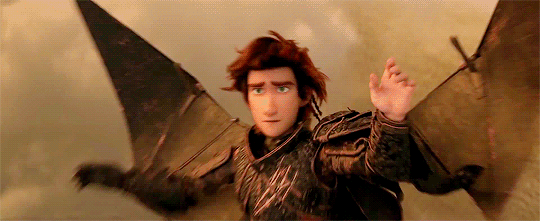
12) Nuffink, Zephyr and the Night Light babies. I would die for them. All of them.
13) The credits with the sepia-toned scenes from the trilogy, what a touching ending, really making use of the beauty the whole team have given to the world. It felt like one last gift to the fans, to me.
Things I’m not sure about:
1) The warlords didn’t seem necessary, I would’ve been satisfied with Grimmel as the sole villain.
2) At times, it felt that Grimmel was there as a means to an end, rather than as a singular, defined villain (but, let’s be honest, WHO was watching it for the villain?)
3) Snotlout and Valka. What. (It did tickle my humour though so....)
4) They just waved goodbye to Berk like that? So quickly?
5) The film didn’t actually start with “This is Berk” and I’m a tiny bit salty.
6) It could’ve been longer and I am excited to see the deleted material.
Overall...
I am so satisfied, devastated and grateful for this wonderful film. Without this series, I don’t think I’d be going to study film at university. I don’t think I’d be anything like myself as I am today at all. And I am so, so grateful for every single minute.

#bri speaks#httyd3#how to train your dragon: the hidden world#httyd3 spoilers#httyd: thw#thw#thw spoilers#httyd#how to train your dragon
159 notes
·
View notes
Text
[神なる君と] Osananajimi Duo - Narumi
This game is like a time capsule from back in the pre-2012 days, before the do-S trend took hold and every playable guy became an abusive asshole. Our heroine has a feisty personality and witty comebacks, and the whole story is packed with funny moments - which just goes to show, Otomate can put out quality stuff... when they want to.
Incidentally I also really love the Shinto theme and the familiarity of rural small-town Japan, which actually makes me a bit nostalgic for the time I spent there.
[Synopsis] 17-year-old Kamiki Sakuya is helping out at her friend’s shrine, when suddenly some strange dude in wasou cosplay appeared under a *magical tree* and started babbling something about a 1000-year promise. When she came to, she had been made the Goddess of the shrine, to replace the current God - the aforementioned strange dude, Mikoto - for a short while until the hoshimatsuri (lit. ‘start festival’), an annual tradition of the town. The main routes take place within this time frame.
*
-Sakaki Narumi-

Narumi is Sakuya’s classmate, childhood best friend, and heir to the Kunihoshi Shrine. From a young age, he has able to see supernatural things, which made everyone think he's a freak and caused his parents to abandon him. His grandfather, the shrine owner, took him in and raised him as his successor. For a while he was bullied by the kids at school due to his abilities, and thus he developed a lone-wolf, withdrawn, thorny personality. Sakuya was the only person who genuinely accepted him unconditionally, and he pretty much fell in love with her at first sight.
Narumi's route basically runs on two ideas:
1. The social position difference, between him (religious minister/'servant') and Sakuya (Goddess). This idea was leveraged in one of his ema minigames, and in the beginning he sort of uses this as a cover up for the real reason they're forbidden to date:
2. It turns out, there’s a 1000-year curse that runs in his family:
1000 years ago, the Sakaki family were well-to-do religious ministers, and the town was protected under a shield by the gods. The family had a daughter, who fell in love with a demon. She let the demon into the town, and he ended up causing great destruction. As punishment, the gods stripped her family of their title and assets, placed a curse on her, and used her as bait to kill the demon.
Despite all this, however, she refused to lift her curse by renouncing her love for the demon and erasing all their shared memories. A certain god (ahem *Mikoto*) took pity on her and erased all her memories anyway #forherowngood, and she spent her last days roaming the land as an amnesiac, trying to reclaim something important that she couldn’t remember.
This curse forbids anyone in the Sakaki family from falling in love with a God or a demon. If they do, they will be gradually deprived of their five senses, until they finally become entirely cut off from the outside world. And for 1000 years everybody has abided by this rule... until Narumi. After Sakuya realised her feelings for him, she tried to confess to him, but got cockblocked left and right by Yakumo (who was probably used by Fate to stop her). Then she wrote him a love letter with hilarious spelling errors, and after he read it, he told her he felt the same way, but they could never be together. ;_;

‘Please be my weirdo.’
Narumi actually thought (mistakenly) that the curse will hurt her, but when Mikoto clarified that it will only affect him, he was immediately like, "LET'S FALL IN LOVE." XD ...It didn't take long for symptoms of the curse to manifest in him. He looked for ways to overcome it, and came to the hypothesis that the hoshimatsuri may be a test of the strength of their #lovebond vs #damnedcurse.
Near the end of the hoshimatsuri he was almost completely senile. So then Sakuya, who had been plotting her own #evilmasterplan all this time, couldn't take it anymore. She took him under the *magical tree* and planned to break their bond right there and then. But then Narumi was like STOP, WOMAN. At which point you have a choice whether to (a) accept his opinion or (b) ignore him because at this rate he's gonna turn into Ronald Reagan.

It sounds almost like she wants to challenge him to a bare-knuckle fistfight under this tree.
a. Good End: Well it turns out Sakuya didn't have to make this choice. While she's hesitating, Narumi kisses her to shut her mouth, and their love successfully overcomes the curse. One year later, Sakuya is being inducted into their shrine as a minister. They plan to go to religious university together to get their religious certification (can you tell I don't really know much about this lol),... and Narumi suddenly drops down one knee and asks for her hand.ヾ(。>﹏<。)ノ゙✧*
b. Tragic End: Through a blizzard of... uhh... white light, Sakuya thanks him for the good times, before their memories are erased. A year later, she visits the shrine and sees him there doing chores. They don't recognise each other at all, but she suddenly gets a momentary flashback of their time together, and starts crying without knowing why. They part ways after exchanging some pleasantries. - This must be one of Otomate's favourite motifs, because it's a sad ending but still makes you feel warm and fuzzy, knowing that they are better off than the actual curse ending.

I feel this way about Life sometimes.
[Thoughts] Ugh, I cried so many times throughout the overall story/this route that I lost count (TдT). There's too many events to mention here, but the curse and its aftermath obvsly caused some kind of time warp, which transported Yorihito Jr. to the future to be mentored by Yorihito Sr. (the mascot statue of the shrine, who was actually modelled after Jr.'s likeness).
Also it's almost certain that Mikoto made Sakuya a Goddess to protect her and/or other people from something related to the curse, and it's just a matter of the rest of the routes enlightening us as to the links between the main characters and the past - who is a descendant of whom, and so on.
I like Narumi as a character, but the route felt like it dragged on needlessly, when he was trying to hide first the details about the curse and then his symptoms from Sakuya. Those things are pretty obvious to us (the player), so I couldn't help feeling a bit emotionally constipated impatient with him at times.
He does have his surprisingly candid moments, too, though. Like when Fuu-san teased them about being on a date and he just smoothly rolled with it (maybe because he thought at that time that they will never be together). And after he read Sakuya's letter, he told her he's always loved her, but they can't be together and he wouldn't tell her why. I can see why Sakuya got frustrated and went into WHYWHYWHYWHY mode after that. Guess it shows that, despite his usual maturity and poise, he's still only 17 and doesn't have the ability to manage both his own feelings and someone else's at the same time.
(On that count I think Yakumo actually manages things in a more adult way, even though he can appear rather mentally deficient at times.)

I wanna have ‘secret muscle training’ session with Yakumo-nii-san... if you get my meaning ( ͡° ͜ʖ ͡°)
I also love the way that Narumi and Sakuya support each other. She comforts him after he failed at making takoyaki, and in turn he consoles and encourages her about the future goals form. They really feel like equals, it's not all one-sided 'big-brotherly duties' like her relationship with Yakumo. (I can't help talking about Yakumo here because I just love him (ノ。・﹏・。)ノ❤. But anyway, he'll get my special attention in a later post.)
One sweet discovery here is that Yuzuru(-senpai) might be a secret romantic. Just as Mikoto was about to repeat what he did 1000 years ago on Narumi and Sakuya, Yuzuru jumps in and is all like: STAHP, shouldn't you let these two choose for themselves? Aww. Assholes with a heart of gold are my favourite assholes in the world. (^o^)丿
2 notes
·
View notes
Text
The Coraline Video game Secret plan Enlarges.
Theo Tkaczevski, a 23-year-old American student living in Asia, discovered himself confronting a mortifying girlfriend circumstance. Though you will not need an Xbox Live Gold registration to get access to Xbox Video games Pass, you will certainly still require this if you intend to access any one of the multiplayer modes in the video games you download. To put it an additional means - great deals occurred on Game of Thrones this week, much from this intense and unpleasant. Fans of Ridley Scott's Gladiator will certainly recognise each Ait Benhaddou and also neighbouring Moroccan communities show up in Game from Thrones also, as Astapor as well as Pentos, respectively.
I may view my duplicate from Forbidden Desert - a video game I have actually defeated each of as soon as - where I'm keying this, as an example, as well as the most ideal this could anticipate from me for the not far off future is a suspicious scowl. Your Android has the electrical power to play nearly every major video game off the last 3 or 4 decades. I saw your blog site regarding 2 full weeks earlier as well as let's merely state you've transformed my lifestyle!
Despite the fact that the activity was confirmed in 2013 as well as our team've right now observed this create an appeal at 3 consecutive E3 celebrations, our team still don't possess a last release day for Kingdom Hearts 3. A higher conversation in between scholarly history and video games feels like an essential portion of recognizing just how we interact along with recent. Should you loved this post and you want to receive details regarding visit the next page please visit our website. George R.R. Martin's book series that encouraged Activity of Thrones" is actually contacted A Song from Ice as well as Fire.
Minister Holidays (0203 733 4931;) gives a five-day Game from Thrones trip to Iceland that includes a time in the company of Jon Thor Benediktsson. In 1984 his moms and dads bought him his very first pc, a Commodore 64. Like numerous 15-year-olds of the moment, Wildenborg largely utilized the machine to play video games, but soon his enthusiasm broadened to feature the way activities were actually created. The Video game On set has been among my favourites and also The Hot Go was a terrific add-on to the series.
There are events and training programs checking out video games as public past history, while the popular online video set, Past Respawned possesses scholars analysing just how activities like Assassin's Creed IV as well as Fallout 4 present record to players, and also just how those players respond. When they were young needed me thus considerably, nothing at all splits via my heart even more than to be helped remind the ladies I deserted. Established by Steal Cage Games, Always keep Speaking and Nobody Bursts calls for cautious focus coming from a highly recommended 2 to 6 players.
Season 1 Description: The Strolling Dead: The Telltale Set - A New Frontier will definitely serve as both a new beginning for players new to the set and not familiar with Clementine, along with a continuation for players which have actually experienced Seasons One as well as 2. You won't be able to refute that the PS4's 900p/1080p HD settlement makes even the cross-platform video games a great deal better.
Advancing purchases of the Pokémon video games arrive at more than 200 thousand copies - and also's not consisting of the Video game Boys little ones purchased exclusively for the video games. In order to help consumers assess their rate of interest in the future game, our experts've put together a list of fifteen factors you should understand prior to you get the game.
What developers have uncovered is actually historic computer games possess substantial beauty, tapping into the mutual social consciousness from gamers. In Around 14 from 3947234829 why The Night Festival is actually better in comparison to this book and also the last ought to never have been compared, TNC takes place in our world. While several present day adventures go the major option, Size 5 Video games heed back to video games like Toonstruck and Sam and also Maximum with oddball conditions, gross-out witticism, and also only-sorta reasonable puzzles.
Sansa's season 4 wedding dress, for example, contained an elaborate pattern from direwolves and also fish, to symbolise her joint Stark and also Tully heritage, while a prevalent cougar at the rear of the outfit symbolized the way Sansa's lifestyle had actually fallen under the management of the Lannisters. Themed Memory: Online mind exams and also games with various motifs, such as African society, pets, birds, movies, dogs, and also travel. Games offer an odds to disregard the anxieties from day-to-day life and unwind.
While platforms have however to become talked about, Eurogamer sources have stated GameCube Virtual Console video games consisting of Super Mario Sunshine, Super Disaster Bros Melee and also Animal Crossing are going to show up. The Azure Home window, a stone arc off the coast from Gozo, is actually found during the course of the wedding ceremony banquet from Daenerys and also Drogo in period one. Stopping is book pair of in the Turning Set that focuses on Bric, Quin and also the profits of Rochelle. As well as this is actually where the politics, an activity from hide-and-seek, plotting and performing start. This is actually, perhaps, a cultural battle also established for one computer game to eliminate alone.
This is the 10th level in Australia's AQF system, and also could feature POSTGRADUATE DEGREE's, M.D.'s, DPT's, regulation degrees, DDS's, as well as a range from other levels, each named for the line of work( s) that they degree is actually related to. Doctoral degrees could take anywhere coming from 3 to 6 years to finish. Conforming on the playing field typically advises individuals to conform of lifestyle in the right feeling, which is just what matters very most, not triumph or defeat. I am actually thus sorry, yet I presume it was my providing for why I was acquiring a 6 web page recipe.
0 notes
Text
The Good, The Bad and The LP: Maestro Morricone
Unpacking the deadly score to THE GOOD, THE BAD AND THE UGLY.
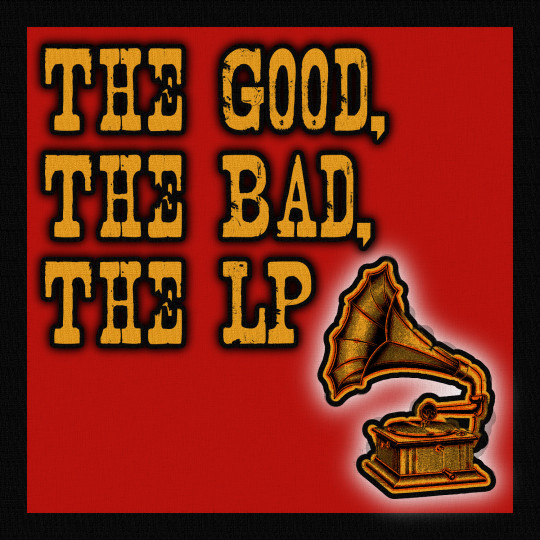
Welcome to The Good, The Bad, and The LP, a column dedicated to the alluring world of film scores and soundtracks on vinyl. Join me, as I take a deep dive between the grooves and look at some of cinema's greatest marriages between sound and vision. As the name of this series suggests, scores and soundtracks of all types are up for discussion; the weird, the wonderful, and even the downright bizarre are on the metaphorical table, or more aptly in this case - turntable.
So without further ado, let's drop the needle and get to spinning...

The subject of this first instalment is one of my absolute favourite film scores and funnily enough the very inspiration for the name of this here column – Ennio Morricone's majestic score to Sergio Leone's 1966 Italian Western, The Good, the Bad and the Ugly. This soundtrack album was a surprise hit and a testament to Morricone's refreshing, unorthodox take on the western score, staying on the charts for over a year following its release and peaking at number 4 on Billboard's pop album chart. Leone's third and final film in what is affectionately know as the “dollars trilogy,” follows Clint Eastwood's enigmatic 'Man With No Name' (the 'Good'), the steely mercenary 'Angel Eyes' played by the inimitable Lee Van Cleef (the 'Bad'), and a charming miscreant on the run by the name of Tuco, played by legendary character actor Eli Wallach (the 'Ugly'), as they form uneasy and shifting alliances in a race across a Civil-War torn America to find a stash of buried Confederate gold. Culminating in one of the most iconic showdowns ever committed to celluloid, The Good, the Bad and the Ugly would not only retroactively stand as one of the pinnacles of the Western genre, but the score would come to typify the sonic palette of the Western in popular culture thanks largely in part to the eclectic, slightly askew and endlessly inventive score by Morricone, the apex of which can be heard in the film's instantly recognisable theme - *WHISTLE* - outside of the terror inducing theme to Jaws, you would be hard pressed to find a more iconic use of two musical notes in the history of cinema.
Here is a little anecdote for you, and full disclosure – I love Westerns something fierce: this album was actually the first film score I ever purchased on vinyl! Not too shabby for a first film record if I do say so myself! In 2012, I went to visit my good friend who was living in Melbourne at the time, James Buttery (a noted vinyl enthusiast who I highly recommend you check out, especially if you want to hear about some fantastic hard to find New Zealand releases). My purpose for visiting (other than to spend some time with one of my pals) was to see Japanese experimental noise rock trio, Boris, and scope the numerous record stores Melbourne has to offer in the hope of unearthing hidden gems I may not have otherwise encountered in little ol' New Zealand.
Unfortunately, things weren't looking too promising on the record pickup front – nothing in particular captured the heart of my music loving soul, let alone the somewhat diminutive but earnest heart of my pocketbook. Don't get me wrong, my enjoyment of the trip did not solely hinge upon successful record store finds, far from it! However, wouldn't it be nice to find treasure? To be the Indiana Jones of vinyl collecting (a 'recordologist' if you will) in the thick of a grand yet complicated adventure, when just as all hope seems lost, an artifact of unspeakable beauty and significance comes into your possession? Well, maybe not as enthralling or roguishly dashing as Mr Jones, but certainly as passionate when it comes to the thrill of the quest. So, you could imagine my heart stopping dead in its tracks upon flicking through a stack to see the faded red frame of an album cover I had coveted since before I had even owned a record. “Surely, it couldn't be,” I said to myself, trembling as my hands lifted this holy grail from its resting place. There, in all its glory, was the record. It was as if time slowed to an incomprehensible haze of euphoria, and strangely, fear; if I didn't get it then, would I ever chance upon a copy again? I don't think I've parted with money faster in my entire life.

For all of the talk given to the reasons why people gravitate towards records in modern times (many of which are highly subjective), one thing that is hard to argue is how the medium lends itself beautifully to artwork; it's just something that you don't truly get with other physical music media such as compact discs or digital releases, and let me tell you – the album art for The Good, the Bad and the Ugly , painted by illustrator and collage artist Fred Otnes is a sight to behold. Laid out with the evocative colour palette of a tequila sunset, the cover is adorned with a painted depiction of the three titular characters of the film above a battle scene from the war; of note, Clint Eastwood's character is literally stepping down into the the battle scene from a position of power, simultaneously foreshadowing the involvement of these characters getting dragged into the conflict, and also suggesting the violent and tumultuous emergence of the new west in the wake of the American Civil War.
Although the original United Artists release doesn't contain the entirety of the score as featured in the film, what is included is a tight representation of its many musical highlights . The two copies I have in my collection (because let's be honest, one is never enough when it comes to holy grails), were released on The United Artists Records label – one is an original 1967 US pressing that I accidentally stumbled across a few years ago in Auckland's Real Groovy in one of those divine moments gifted by the universe; the other is the aforementioned Melbourne discovery, a 1968 UK first pressing. Both pressings sound absolutely fantastic – turning the volume up reveals an energised sonic palette, with the authoritative low end of thunderous percussion and orchestral strings carrying enough power to shake the foundations – let's put it this way – The Man With No Name and Tuco would have had no trouble blowing a bridge up with this record in place of dynamite. The mid range and high-end reveals a raggedly gorgeous bite, particularly evident in the electric guitar sound, with its glassy distorted sting contrasted arrestingly against the background orchestral arrangement.
Much like the film's visuals, so much of the aural charm comes from the imperfections of the medium, recording environment and technology employed, which we'll get to in practical recording terms a bit later. Sergio Leone's use of Techniscope, an inexpensive film stock that exhibits a more pronounced film grain when enlarged to Cinemascope projection size, resulted in a visual image that gave a gritty toughness to the presentation. The uncanny knack Leone had for framing actors with amazing faces attained a whole new level of lived in dirt and grime when coupled with the added grain texture; facial hair stubble on-screen exhibited a coarseness that suddenly gave the illusion that one could light a match when struck against it. This film was mean and dirty visually. Comparatively speaking when compared to what came before, to borrow a parlance, “this ain't your daddy's western.” Similarly, Ennio Morricone's score was unlike any American Western score that had come before it.
youtube
As the main title theme to The Good, the Bad and the Ugly, encompasses so much of what makes the entire score unique, I am going to pull apart some of the more idiosyncratic elements that I find to be, well, just darned right clever as a set of spurs that enter through the window instead of the door, to paraphrase a man by the name of Tuco. As is widely noted, Morricone's main musical motif, *WHISTLE,* inspired by the howling sound of a coyote, is a shared theme of sorts for all three main characters, and as such, is wonderfully categorized by three distinct sounds: For Blondie, a.k.a. 'The Man With No Name,' this motif is played by a flute, for Angel Eyes, an ocarina, and for Tuco, by human voice. Now, this is a seemingly simple thing to have in place, but it is what each sound represents and evokes from a character standpoint that makes it brilliant.
Morricone scores the credit sequence instrumentation as such, to get to the core of who each character is immediately before the narrative even begins. With the choice of flute for Blondie, Morricone uses a light timbre, rather chirpy instrument played in a higher register to represent The Man With No Name's inherent goodness. The tail end of this musical phrase, is punctuated by the sound of a harmonica, using traditional western aural iconography to telegraph Clint Eastwood's character as signaling the coming of something familiar, yet somehow different... he is, the new west.
Here is where things start to get rather excellent. For Angel Eyes, Morricone employs the pure and natural sounding tone of an ocarina, an instrument I am sure many of you gaming fans out there are familiar with due to a little known title called The Legend of Zelda. This instrument has a slightly fuller, deeper timbre than a flute and is played an octave lower than what was used for Blondie. The simple act of making Angel Eyes' part of the theme sound deeper than Blondie's, both in terms of instrumentation and register, very clearly and literally delineates Angel Eyes as being lower than Blondie in a moral sense. In the scene that introduces Angel Eyes as 'The Bad' not far into the film, the ocarina motif is punctuated by the dastardly twang of a low register electric guitar. Angel Eyes becomes a mysterious and elemental force of nature, deadly and not to be trifled with. Already in a short musical space, we can vividly see the characters in our mind's eye.
When it comes to the character of Tuco, Morricone takes a bit of a risk and employs human voices to underscore the fact that Tuco in many ways, is the most human character of the trio – rough around the edges, endlessly fallible, and yet somehow endearing as heck. One can't help but cheer Tuco on – sure, he's a bastard, a scallywag, a good fur-nothin' rapscallion, but there's a complexity to him – a grey area that escapes easy classification, neither good or bad, and harder to pin down – more messy and chaotic. If that's not human, I don't know what is. When one initially listens to the human cries of 'AAAHYEAAAHYEAAA,' it is very tempting to dismiss it as being utterly ridiculous. I mean, it's hilariously startling compared to what precedes it, but that's the point – it's joyous, strange, and replete with a cackling kind of energy, which is most definitely Tuco to a capital 'T.'
Sergio Leone worked very closely with Eli Wallach in the creation of the Tuco persona, suggesting a great affinity for the character. Tuco in fact is the only one of the three leads we get to learn about in more than passing detail. The sequence where Tuco confronts his brother, catholic friar Father Pablo, reveals an underlying sadness and regret. Later in the film in an emotional scene which effectively juxtaposes on screen violence with music (hello there rabid fan of this film, Mr. Quentin Tarantino), Tuco is tortured to the mournful sounds of captured soldiers performing outside the room of interrogation to mask the sounds of abuse within. The coyote howl may be indicative of a wild animal, a potentially dangerous one at that, but beneath the teeth, the snarls and the bravado, remains a painful, plaintive cry.
So, in the main theme, we have our three characters covered, sharing the same motif inspired by the solitary call of a coyote, but represented individually by having different instrumentation. Another central presence in the film, is that of the soldiers of war. Here, Morricone uses trumpets played in rapid, staccato like-fashion to evoke the rousing charge of battle. In an example of Morricone's lateral approach to score, he uses the cacophonous sound of spring reverb to sonically stand in for the conflict of war – the rattling sound that is heard during the trumpet solos of the main theme, is quite literally produced by kicking a reverb tank, a spring loaded contraption used by electric guitarists in the sixties to produce the lush, wet sound of the surf guitar genre. Talk about the old western genre getting a kick or what!
To cap it all off, we have the striking use of electric guitar. Morricone, having come from a background in pop music arranging at RCA records, brought into the score for The Good, the Bad and the Ugly the sound of heavily reverbed electric guitar. This appropriation of a populist instrument into the western genre, an outsider move if ever there was one, is the final piece of what makes this score so memorable. When thinking of Morricone, it's hard for the mind not to jump straight to whistles, human coyote howls, and the twang of a Fender Amplifier cranked all the way up to 10 (eleven being strictly reserved for Marshall amps only – THANKS SPINAL TAP). In Morricone's metaphorical hands, the electric guitar becomes a weapon – sharp, shrill, and bloody deadly. This instrument also becomes the thing that links all men in the film, with its seductive sound cutting though (and ringing out rather obnoxiously over) the orchestra implying the notion, and some may say folly, of power and violence - take the Native American-like chants that are contrasted against guitar in the theme. Leone was explicit in saying that the film was a deconstruction of traditional Western narrative and iconography with its focus on violence and anti-war themes. Morricone seems to have taken Leone's lead in this regard, suggesting an unending cycle of violence in this sonic contrast. The violence of American colonisation that the chants evoke, is challenged by the new emerging sounds of a violent Civil War, represented by the electric guitar. In Leone and Morricone's world of mercenaries, bandits and soldiers, it would seem violence, begets violence.
It would be remiss of me in a discussion of The Good, the Bad and the Ugly, to not mention (in my opinion) one of the greatest pieces of music ever put to screen. Cue, 'The Ecstasy of Gold'
youtube
'The Ecstasy of Gold,' marks one of the great turning points in the collaborative relationship between Leone and Morricone. Prior to filming, unlike with what transpired making the other 'Dollars' films, For a Fistful of Dollars and For a Few Dollars More, Morricone actually was asked to compose a few of the tracks for Leone to play on set for inspiration. In fact, this process ended up being so successful that every film Leone worked on with Morricone post The Good, the Bad and the Ugly utilised this method of preproduction composition prior to filming, which is an uncommon practice even today. One of these such pieces was 'The Ecstasy of Gold,' and it is immediately noticeable how much influence the musicality of the track had on Leone's compositional and pacing decisions in the featured graveyard sequence toward the end of the film. The cyclical, escalating nature of the song is reflected on-screen in the frenetic circular panning of the camera, keeping Tuco in focus with the surrounding graves in the background becoming increasingly visually incomprehensible as the sequence reaches its euphoric climax, when Tuco discovers the grave marked 'Arch Stanton.' (By the way, how great a name is Arch Stanton?!?) Outside of the film, the song has become well known in music circles for its use as the introductory entrance music for Metallica's concert performances – say what you will about the merits of Metallica, but they sure know how to co-opt a hell of an epic song for a prelude.
Not a terrible amount is known of the exact details behind the score's recording sessions – we do know the score was recorded in Rome at International Recording Studio (quaint name, I'm sure you'll agree) in 1966, with fellow composer and conductor Bruno Nicolai conducting Morricone's score with the Unione Musicisti di Roma as his sitting orchestra. Accounts of the sessions being hastily arranged as the film was being edited gain weight when considering Morricone's ridiculous scoring output at the time. Contemplate the following: by the time The Good, the Bad and the Ugly was released in Italy in 1966, Morricone had already scored a dozen other projects that year. That folks, is the creative force of a musical sledgehammer (other than Peter Gabriel of course) obliterating all manner of competition. No wonder the man is rightly regarded as an institution unto himself.
I'm going to get into a bit of recording insider talk here, so bear with me! It'll pay off in just a moment, I promise you. Most orchestral recordings are achieved primarily through a recording technique which was developed in the early 1950's called a Decca Tree, named after the record label the practice originated at, Decca Records. In this method, three microphones are arranged in a 'T' shape to make a figurative tree, usually placed behind and above the conductor – when mixed down, the end result is a natural, well balanced stereo sound that wonderfully captures the nuances and details of orchestral recordings in large acoustic spaces. Other microphones, termed spot microphones, can be added closer to individual instrument groups in order to fill any sonic gaps so to speak, but the core of the sound comes from this Decca tree arrangement. Based on an interview with Morricone's long collaborative recording engineer, Fabio Venturi, and from what was common practice at the time, it is highly likely that the sessions were recorded in this manner. Okay Dan, pretty standard stuff thus far.
So, imagine this if you will: your typical orchestra is arranged in wait, ready to perform, eagerly anticipating the first graceful flick of the conductor's baton, and yet, something is slightly amiss... Let's say, you were a violinist in this session – the title theme begins – you're there minding you own business, waiting for your turn to shine when seemingly out of no where, someone starts to whistle – intentionally – not some nervous new player getting caught up in the melody of the piece, but a professional who was paid to be there. Odd, to be sure to be sure, but nothing that's going to make the pillars of the earth shake. Composing themselves (and yes, that pun is terrible and yet somehow absolutely necessary, if not for anything other than my own amusement), the violinist focuses once more and the piece starts moving along, when BAM – off to the side, the piercing sound of a vengeful surf guitar makes itself known in all its electrified glory. What on Earth is going on here? By this point, the violinist is breaking into a cold sweat. The guitarist has put in their two cents worth, and the main melodic motif returns. Only this time, it's not flutes or ocarinas playing the melody – it's the startling sound of humans, imitating the howling cries of a coyote. The violinist, being the professional that they are, keeps playing, but their mind is no longer of this world, having been shot through the ether into outerspace from a cannon of unfathomable delights (which is incidentally the first and only time you'll hear a cannon be described in such terms - well, that is until the sad but inevitable Good, The Bad and the Sexy parody is made, but that dear reader is a whole other kettle of kittens).
Anyway, the point of that somewhat wordy diatribe was to get across the idea that this recording ensemble had a quirky edge that most other score recording sessions up to that point did not. Having eclectic and unusual instrumentation, and case in point an electric instrument thrown into the mix, adds an extra set of considerations and side effects to the technical process of sonically capturing Morricone's score. The added volume, or as I like to think of it as, pure gumption, pushes the meters – that is to say, the combined room sound of orchestra plus electric guitar when captured by the Decca Tree and additional spot microphones, hits the recording console harder than usual and subsequently saturates the tracking tape machine (hey, remember those?) in a more exaggerated fashion. This saturation, while technically distortion, is aurally pleasing due to its very analogueness. In fact, the imperfections and quirks that the recording methods and technology of the era afforded – the slight presence of noise; the scrappiness of it all; a certain je ne sais quoi - couldn't be a more apt pairing for Leone's beautifully rugged visual swagger.
“So Dan,” I hear you say, “what can you tell me about where I can track this sucker down?” For the digitally inclined who wish to experience the score's majesty this very instant - perhaps for the first time; maybe you've heard it a gazillion times, and just want to pay a casual visit to the house that Morricone built – you can find a couple of different versions on Spotify. They are more or less identical, save for the tracks 'The Story of a Soldier, ' and 'The Trio,' which are both longer on the Italian soundtrack remaster that clocks in at 59 minutes as opposed to the standard Capitol version which is 55 minutes. Either way you go, you're going to be winning at life so don't fret too much!
On the vinyl front, from what I have heard, the recent Back to Black reissue from 2015 is a bit hit and miss when it comes to sound quality and noisiness, but as it goes with these things, give it a spin and trust your ears before you buy if at all possible. If you do happen to come across a reasonably priced secondhand pressing from the late sixties or early seventies in the wild however, don't stop and think about it – lay that money down and walk out with one of the greatest scores ever cut to tape, and put on wax.
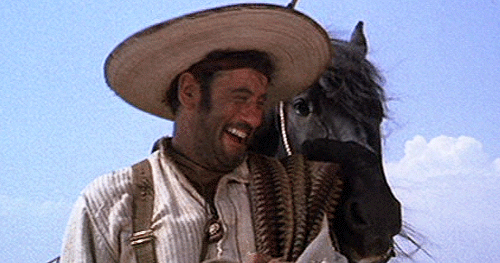
Listen on Spotify:
0 notes
Text
#24 Answer
One of my best friends lives on the other side of the world. We have known each other for over 20 years now. So alongside the deep affection of long friendship we also piss each other off with a level of skill and subtlety that no one else in our lives is capable of, barring possibly our siblings. This week I was thinking about how enraged I used to become when he would read my Facebook messages to him but not reply, so I wrote some music reflecting on it. It was all the more infuriating because I could see that he had read them. I’m sure you’ve experienced this in some way, it can really drive you nuts if you let it. Since he moved overseas a few years back I have had to learn to not care but something I read this week reminded me of it and I wrote some words on Monday reflecting on the idea.
György Ligeti is one of my favourite contemporary classical composers and is considered one of the most important avante guard composers in the 20th century. My first introduction to him was through the work Lux Aeterna (this is actually one of my favourite pieces of music), a work for 16-art choir that uses clusters of sound and obscured rhythmic development to forefront the texture and timbre of the work. You may recognise if from the soundtrack to Stanley Kubrick’s 2001:A Space Odyssey. The main compositional technique used in the work is one Ligeti developed himself and called “micropolyphony”. One way to think of it is many melodic lines occurring together like a canon and therefore producing a variety of chords and clusters vertically. György puts it a little more poetically:
"The complex polyphony of the individual parts[,] embodied in a harmonic-musical flow in which the harmonies do not change suddenly, but merge into one another; one clearly discernible interval combination is gradually blurred, and from this cloudiness it is possible to discern a new interval combination taking shape."
I experimented with this idea on a much smaller scale this week. The opening line for #24 Answer uses the word ANSWER as a musical motif by transferring the letters into numbers and then the numbers into notes. The resulting line is C, C#, F#, A#, E and F. I created a single line and then staggered the entry of the other instruments. I was pretty happy with the sounds I was producing but I wanted another layer of texture over the top. Considering the Facebook link/theme, I searched for some stock sounds of the sending and receiving message functions. I played around with time stretching these sounds and then layered them with the opening texture and was happy with the results.
The jagged strings motif in the middle was inspired by a moment about 10 minutes in to Ligeti’s 2nd String quartet. I enjoyed how this part began in a complex polyrhythm and then somehow stumbled into a tight rhythmic motif. I spent quite a while trying to produce this idea using the different grid settings in Logic’s piano roll. In the end I decided it was easier to just play in what I heard.
I’m not entirely happy with the outcome of the work. I find that when I start experimenting with denser avante guard ideas that a week is not enough to see things through to my satisfaction. It also took a lot of time to program the midi string elements, especially as I was writing and experimenting at the same time as programming. I can’t believe that next week will be the halfway point! Nothing special planned, just going to let it flow out and not think too much. As always thanks for listening and reading.
0 notes